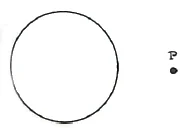| 251. The History of the Anthroposophical Society 1913–1922: Second Farewell Address to the General Assembly
08 Feb 1913, Berlin Rudolf Steiner |
|---|
| 251. The History of the Anthroposophical Society 1913–1922: Second Farewell Address to the General Assembly
08 Feb 1913, Berlin Rudolf Steiner |
|---|
So, my dear friends, we have finally come to the end of our meeting, but we can highlight one fact in all of this. You see, my dear Theosophical friends, something extraordinarily important seems to have taken place. One might ask: Was it a general assembly? What was it actually? When it is talked about later, it will be said, “Once upon a time...” — just as it is said in fairy tales. We were still members of the Theosophical Society in Adyar when we arrived here, but now we are no longer members. Something earth-shattering seems to have happened, but in terms of the matter, one has not actually noticed it. We are again diverging in terms of the matter, as we used to diverge, and precisely this fact, that we can do that, that we do that, is a very important one. Perhaps this does testify to how serious we were about the spiritual, about the cultivation of spiritual culture, about the content of our cause; and if we were serious about that, no form will break this content, but this content will seek its new form if the old one is challenged. As for myself, my dear Theosophical friends, I must confess that, with regard to the external events that have occurred, I have been so touched by the matter that I must say again: things actually only differ in degree. You see, Mrs. Besant has found it necessary to make the claim, which defies all facts, that I was educated in a Jesuit school. It is so that one must take it seriously, because it is a very strong accusation in the present, and effective if it were believed in relation to the inner, to the hateful motives. And with regard to the other underlying motives of Mrs. Besant, I find only a slight difference compared to another accusation that came across my eyes, from a letter that is one of a whole series of letters. I received a letter from Hamburg in which a lady writes that she had always been persuaded not to go to the lectures, but now she had seen for herself, because before she never went because a pastor had said that I was a Satan. I have not yet read the other letters, but there is one coming every day, sometimes two. Shortly before the lecture here in this hall, a letter was brought to me – I should definitely read it before the lecture. In the letter, a lady wrote to me that she had heard some of my lectures that she liked. But now she looked me up in the dictionary of writers to find out how old I actually am, and she discovered that I carefully dye my hair, because people my age don't have black hair anymore! So she can't come to my lectures anymore, because it would be outrageous and speak to the prevalence of such a thing. You hear all kinds of things and finally, the accusations are to be distinguished according to the motives for how they are made effective. The motives are human, all too human, whether one or the other makes them, whether one is accused by Mrs. Besant of having been educated in a Jesuit school or by another lady because of something else. That's how people act. There are many more stories I could tell. Something that really did meet with the enthusiastic support of our friends – the printing of the cycles – is also being made the target of attacks. I am being reproached for the fact that it says: “According to a postscript not checked by the speaker.” But there is a very simple reason for this; I don't have time to check the postscripts. They would never see the light of day if I had to read them first. The person concerned says: He – Dr. Steiner – has not looked at the matter, so he always leaves himself a back door open if he were to be caught making mistakes. In this way, one can suspect everything, while we have really only taken into account the energetic wishes of the members. We are dealing with serious, profound, and meaningful things, and so we must be able to fully distinguish between what is a serious and sacred matter and what is an external form, and we must not sleep and believe that we can always dream and talk about the content to get ahead. The worst things could happen to us if we were not on guard, if we did not take into account the need to remain vigilant. And in this respect, I was also able to tie in with what Dr. Peipers said today, the word about keeping watch. There is also a productive way of keeping watch. That is in our nature and not in that of our opponents. I hope that we will part peacefully, with the feeling that we will remain united intellectually. Goodbye! |
| 251. The History of the Anthroposophical Society 1913–1922: Second General Assembly of the Anthroposophical Society — Day One
18 Jan 1914, Berlin Rudolf Steiner |
|---|
| 251. The History of the Anthroposophical Society 1913–1922: Second General Assembly of the Anthroposophical Society — Day One
18 Jan 1914, Berlin Rudolf Steiner |
|---|
Wilhelmstraße 92/93, House of Architects Report in the “Mitteilungen für die Mitglieder der Anthroposophischen Gesellschaft (Theosophischen Gesellschaft), herausgegeben von Mathilde Scholl”, No. 6/1914
My dear friends! On behalf of the Executive Council, I warmly welcome you to the second General Assembly, the first ordinary General Assembly of the Anthroposophical Society! For as long as we have held general meetings of the Theosophical Society, it has been customary for the General Secretary of the Theosophical Society to also chair the general meeting. However, it is the right of the general meeting to elect the chair. On behalf of the board, I propose that Dr. Steiner be elected to chair this general meeting. I ask you to vote on whether you agree to this.
Dr. Steiner: My dear Theosophical friends! We are gathered here for the first time in a regular General Assembly of the Anthroposophical Society, and it is my duty to greet you most warmly and to express my joy at the large number of you who have come. I would also like to express the hope that this first General Assembly of our Society will be fruitful in all respects. My dear friends, you have surely brought with you hearts filled with an anthroposophical spirit for this day, hearts throbbing with the enthusiasm that is necessary if a spiritual current is to be brought into existence in the world, a spiritual current like ours, which can certainly, without being guilty of the slightest exaggeration, be said to have to be born in pain. And from the many antecedents that have befallen us in recent times, it will indeed become clear that we have a great need to approach our task with great seriousness and a certain urgency at this time. Before I try to continue the train of thought that I have stimulated with a few words, I would like to dedicate the word to those who have left the physical plane since we last gathered here and, as members of our movement, which is so close to our hearts, now look down on our work from the spiritual world. I would like to take this opportunity to emphasize once again that those who have passed away from the physical plane will continue to be considered our members in the most beautiful sense of the word, and that we will feel united with them as we did when we were still able to greet them on this or that occasion on the physical plane. First of all, we would like to remember an old theosophical personality, old in the sense that she was connected with what we call true, genuine theosophical life for the longest time of most of our ranks, Baroness Eveline von Hoffmann. She is one of those who have imbued their entire being and active will with what we call the theosophical attitude. Many have come to appreciate the deeply loving heart of this woman, if only because they have felt infinite strength flowing from this heart in times of suffering and adversity. Although little of this became known to the outside world, Mrs. von Hoffmann was a loyal and self-sacrificing helper to many. And we may consider it a particularly valuable thing that she, who had been involved in theosophical development for a long time, was last in our midst. And with her dear daughter, who is still with us, we will keep the memory of this loving, loyal, and helpful woman, who wants to be united with her in the spiritual world. I also have to remember some old members who left us for the physical plane this year. I have to mention our dear old friend Edmund Eggert in Düsseldorf. If some of us perhaps know the great inner difficulties that our friend had to struggle with, the heroic strength with which he became involved in what we call our spiritual current, then those who knew the good, dear man will certainly join me in making unceasing efforts to continue to be loyal friends of our dear Eggert in the spiritual worlds. And those of the dear friends who hear this, what I say from a troubled heart, will faithfully send their thoughts to the one who has passed from the physical plane. I also have to remember a dear, loyal member, a member who always gave us sincere, heartfelt joy when we were able to see her in our midst time and again, our dear Mrs. van Dam-Nieuwenhuisen from Nijmegen, who left the physical plane this last time, and who certainly was one of the most beloved personalities among those who were her close friends, who worked faithfully for our cause as long as we knew her, who in particular also did a great deal to ensure that our cause was appropriately represented among our Dutch friends. I must also mention a loyal, if perhaps quieter member, who always gave me great joy when I was able to see her in the circle of our dear Nuremberg friends, Fräulein Sophie Ifftner. She was much appreciated in the circle of our Nuremberg friends, who will ensure that the way is created through their feelings so that we will always find her when we seek her in the spiritual worlds. I would also like to mention another faithful friend who has been active within the circle of our worldview for many years. She has been tragically recalled from the physical plane to the spiritual worlds. I would like to mention one of those to whom she has become dear and precious, and who want to be and remain with her in their thoughts, Miss Frieda Kurze. I would also like to mention our Julius Bittmann, who was torn away from his dear family and from us, until his last difficult days, the fixed point of his inner life, despite difficult external circumstances, in what we call Theosophy. It was a deep joy for me to be able to spend the evening before the death of our dear Bittmann at his side once more, and I am sure that those of our friends who were closer to this man will not fail to form the path here as well, on which the theosophical thoughts unite us with the friend in the spiritual world. I must also mention Jakob Knotts in Munich, who was a man who, after all his various struggles in life, finally found his firm support and his definite point of reference in Theosophy, so that his friends will be his mediators in the same way. I must also mention another friend who left the physical plane during this period. Mr. Eduard Zalbin, who had come to us from Holland, was sadly mourned by his wife and children when we saw him depart from the physical plane through a quick death. Shortly before this occurred, Zalbin was still at our last general assembly, and his departure from the physical plane had to be pointed out there. I would like to remember an old friend of the Stuttgart Lodge, who had organized her innermost life in such a way that she associated everything she thought with Theosophy, and who will now certainly be surrounded by the thoughts of all those who knew her, Miss Duttenhofer. I must also mention Miss Oda Wallers, who we felt was connected to our cause with all her soul, for a long time. She was one of those souls who was as loyal to the cause as a human soul on earth can be, so loyal that we not only saw this soul depart from the physical plane with deep sorrow – a sorrow that does not need to be particularly emphasized in this case because all those who knew Miss Oda Waller knew her, felt it with the deepest sympathy – but at the same time we looked up to her in the spiritual world with the most beautiful hopes, with those hopes that are justified in the case of such a faithful soul, who, like Oda Waller, has firmly established in her heart to remain connected to the theosophical cause for all time. There will be more than a few who, united with their dear sister Mieta Waller, will be in heartfelt contact with our dear Miss Oda Waller. I have to remember our Munich friend Georg Kollnberger. Those who knew him will be our mediators when we reflect on him with our feelings and emotions. I have to remember a dear friend in Bonn who left the physical plane not so long ago, Miss Marie von Schmid. Those who knew her feel deeply how closely connected Miss von Schmid's soul was to the spiritual life. Those who felt a close connection with Miss von Schmid, a soul so open to the spiritual life, have lost a great deal, as have those who felt a close connection with an outwardly shy and withdrawn nature. It is so pleasant to meet such a nature in life. Precisely because she was so reserved, we got to know her so little. Those who knew her understand what I mean by these words. We have to remember a member who, in terms of his physical strength, was unfortunately taken from us all too soon, a man who was happy to put his physical strength at the service of our cause, but who will also be an esteemed member in the form in which he is now connected to us, Mr. Otto Flamme in Hannover. I must also remember our friend Fräulein Munch, who was found in the circle of our Nordic friends in our midst, and who, after a long, heroically endured illness, despite the most careful and loving care, finally had to leave the physical plane. Perhaps those who were closest to her will have the most understanding for what I would like to say about this soul, when we consider how she clung to the theosophical cause, I would say with inner strength, and passed through the gate of death with it. I would also like to mention a friend who had also become acquainted with our friends in Berlin and who, after long and severe suffering, has recently left the physical plane. She was fully aglow with the yearning to implement in practical life on the physical plane what shone so beautifully for her heart and soul. We are sure that she will now continue her work in other places in a way that we also assume for our dear friend Flamme from Hannover. All those who have passed away, as well as those who have become less well known in the circles of our members, we remember in this solemn hour: Mr. Brizio Aluigi from Milan, Mrs. Julie Neumann from Dresden, Mrs. Emmy Etwein from Cologne, Mrs. E. Harrold from Manchester, and we affirm that we sense, we want to live with them in thought – with these dear departed members, who, after all, have only changed the form of their way of life for us – that we want to surround them with the forces and thoughts with which we are accustomed to connecting with those friends who have left the physical plane; we affirm this will and remembrance by rising from our seats. Dr. Steiner continues: My dear friends! First of all, I have to read out some letters that have been sent to the General Assembly of the Anthroposophical Society.
I am sure that you will all accept these very warm greetings with thanks. My dear friends! Perhaps I may, in accordance with the custom of earlier years, say something in advance to this assembly; something that is really meant not otherwise than as a kind of greeting from the bottom of my heart to your hearts and souls, a greeting that I feel so deeply this year because we are united in this way for the first time within our Anthroposophical Society. For in a sense, the constituent assembly that we had to hold last year was what we had to hold. But only this year have we been able to see how many souls want to walk with us. And it shows itself to us through your extraordinarily large attendance. Perhaps it is right, at the very point of origin of our anthroposophical endeavors, to bring ourselves face to face with what we actually want to be with our goals and endeavors. When we turn to these goals and endeavors with our thoughts, two feelings must prevail in our souls, side by side, for they can hardly go hand in hand. One is a deep awareness of the necessity and importance of the spiritual life, to which we want to be devoted in our time with seriousness and loyalty, a feeling that must be connected with the earnest desire and the striving for sufficient energy to participate in what can deepen our time spiritually. The other sentiment that must go hand in hand with the first is what one would call, not wanting to be sentimental, but precisely in order to express something quite serious: the humblest modesty. Only in the humblest modesty and in the feeling of our inability to accomplish the great task can the necessary counter-image be created in our souls to what could so easily lead to an overestimation of ourselves and to pride. Because that is precisely the most important thing: the seriousness, the importance and the dignity of spiritual striving on the one hand; on the other hand, we can only advance in the right way on the path we have chosen in the most humble modesty towards our inability. And, my dear friends, if I may now pick up on the first thought that was expressed, we must never lose sight of the need for true and honest spiritual striving in our present time. What I would like to tell you, I must summarize here in a few words. But there are some things I do not want to leave unspoken. What is connected with the serious feelings is what must make us attentive to the whole course of the spiritual life of our time in the broadest sense. In particular, this makes it my task time and again to point out, in a way that I certainly do not seek from a different point of view, these or those other spiritual currents, which should truly not be fought in a superficial way, but only to show how little they are suited to meet the deep, serious longings of the souls of our time. But people do not yet know about most of the deep longings that are present in the souls. Unconsciously, they rest in the depths of the souls. But the spiritual scientist tries to dive down into these depths of the soul. He knows how necessary it is to make progress in this area and to integrate spiritual science into the currents of life as far as possible. People today do not always admit that there is something in the depths of the soul like the call for these spiritual necessities. But anyone who clearly sees in the eye of the mind what souls strive for without knowing it in their innermost being can find this silent, silent call for spiritual life everywhere. And this call becomes a duty in our soul: to work together on spiritual work in order to make progress in this area. One symptom is shown of how these or those personalities fight us, how they refute us and describe the things that come to our attention through our teaching as fantastic and unscientific. Sometimes, however, they give themselves away in the way they reject something, and by rejecting us they show that in fact they agree with us at the deepest level. Perhaps one of the most daring assertions that I have often made is that the materialism of our time, the monism in [contemporary] intellectual life, is based on fear. I have had to experience it that people from the audience, especially after such statements, approached me after the lecture and were horrified by such a grotesque assertion. I will not mention any names, I will only mention one man who has already achieved a great deal for our present intellectual life, who bears a revered name in connection with the name of our great Schiller, Alexander von Gleichen-Rußwurm, who belongs to the descendants of Friedrich Schiller, and who has already achieved a great deal. I will quote his words, which—one might perhaps call it “coincidence” if one were not a theosophist—yesterday “karma” delivered to my desk:
Please pay particular attention to these words: “We are all afraid.” Here you have expressed the opposite point of view to our own, which has been expressed again and again as a result of decades of research: that all clinging to materialism arises out of fear. So, sometimes people betray themselves by saying things that show how right we are with our views. We hear, when people betray themselves, especially when they put their hand on their heart, affirmations such as: “We are all afraid in this nocturnal darkness...”. One must look at what is going on between the lines of present life. Then one will feel the justification that is emphasized by the necessity of our spiritual work. And, my dear friends, however slowly it may proceed, we do see fruits that show us how what is sought in spiritual heights can be implemented in practical life. I would remind you of a saying that I have taken the liberty of saying and writing often in the course of the striving of our German Section: on the one hand, our task is to search for the secrets of the spiritual worlds, to make that which we can explore , to make it our spiritual heritage and to care for it among those who belong to us; on the other hand, our task is to make fruitful in the right way what we are exploring in the spiritual life in our lives, wherever we can. And we see fruits in this respect too - I would like to mention just one symptom. Souls are maturing in our midst who, we may say, are willing to carry into the place in life where they are placed, what can be won on our ground, even outside the circle of our Anthroposophical Society. Among many beautiful phenomena, let me mention one because it was deeply satisfying for me. Our young friend Karl Stockmeyer wrote a significant essay in a journal for the Baden school system about the impossibility and impracticality of what is being striven for from many sides: to use the cinematograph to teach mathematics in schools. It is wonderful to be able to guide the soul along such paths through the problems of life, where something can be gained if one engages with the way we have to approach the matter. This is exemplified by our dear young friend Karl Stockmeyer, who in such a modest way allows what has become his to be exemplary for what is meant when I have repeatedly said and written: In addition to cultivating the wisdom treasures, one should also make practical use in life of what we can gain in our souls from these wisdom treasures. I would like to sincerely request that as many of our friends as possible familiarize themselves with the unpretentious but very valuable essay. I always want to speak only symptomatically about such things, I want to speak so that it can be seen from the example how the things are meant. What we strive for from spiritual heights can be fruitfully applied in the particular. So when we try to bridge the gap between our spiritual values and the demands of practical life, we will gain the opportunity in many ways to let real theosophical-spiritual striving, anthroposophical spiritual life, flow into the life of the present. And such a task we have, we have a task! I would like to place all the emphasis I am capable of on this simple word: we have a task to carry into the world in a proper and correct way what we recognize as being right, what we are able to research. The mood in the world is not one that makes such a task easy. There are people who call themselves theosophists and who have done much to tarnish the reputation of the name “theosophy”. All the more reason for us to take on this task when people who believe they are at the height of spiritual culture repeatedly condemn us for giving a bad name to theosophy. For example, in a German journal, 'Die Tat', Giuseppe Prezollini uses strange words. In a lengthy essay, he describes what he means by theosophy. He starts by talking about all kinds of philosophical schools and characterizes them - one might say - wittily. Then we have the following sentence:
My dear friends! It is symptomatic that such things are written by people who are taken very seriously in their field. We must really bear in mind that what presents itself to our soul as a duty, that we have to regard a sacred belt in such a way that we have to stand up for it. The direct transition is made in this essay from philosophical education to the university. I would like to make the transition to the German university. All kinds of cheap books are appearing today. There is a collection; “Bildung der Gegenwart”; in it there is the following chapter on modern theosophy:
So now anyone can educate themselves about Theosophy for little money. But what is distressing is that this is in a treatise on the “History of German Philosophy from the Beginning of the Nineteenth Century to the Present”. What is distressing is that the man who writes this refers, for example, to something that I certainly never quoted as a source: a Buddhist catechism, a superficial compilation that no serious person can use. He goes on to quote the “Secret Doctrine”. But then he gives the sources from which he has informed himself; he mentions Hans Freimark's (!) “Moderne 'Theosophie” (1912). But that is not yet the distressing thing, because if an ordinary writer had done that, it would not have meant anything for our culture. But this is written by the full professor at the University of Giessen, Dr. Messer. We learn from it how official representatives of the highest intellectual life judge us. We must conclude: this is how men who teach our youth today write. With such conscientiousness, a licensed professor of philosophy, an official representative of science, teaches himself about things. Is one not entitled to conclude from this: if this man writes and teaches about Kant, Fichte, and Schelling, how is our youth taught today? I do not want to say anything against the views that Messer presents against Theosophy. It is not this opposing criticism that concerns me, but how the man who writes such things informs himself about the things. What value can his explanations of Fichte, Schelling, Hegel, etc. have if this is how the man informs himself? How, then, did that which is currently being disseminated as “science” and so accommodatingly believed by many come about? Can one not see the bleakest of circumstances here!? I am not talking about the fact that Messer is our opponent; I am talking, independently of that, about the nature of his “scientific conscience.” The final sentence in Messer's account reads:
Undoubtedly, there is sometimes good will and the belief that something is known associated with what today calls itself philosophy and the like. Nevertheless, it will take a great deal of serious and genuine spiritual striving to put the incredible arbitrariness and ignorance that is spreading today into the right perspective for our time. I do not wish to shrink from pointing this out in a fitting manner, in order to show how deeply significant what I understand by seriousness and dignity is, and how it must be taken if we want to help what we call our spiritual heritage today to find its appropriate place in the world. Those who know how I avoid saying such things on all other occasions will forgive me if I put these things in their proper light on this occasion, in order to show how things stand and what tasks we must take on. My dear friends! If, on the one hand, we link these considerations to the feeling of how serious and necessary our task is, then on the other hand, we should never forget how incapable we are, how modest we must be, how we must know how little we are actually capable of in the face of our great task. I am convinced that those who understand me will always adhere to this most humble modesty. So we must endeavor to bring our spiritual knowledge to people in such a way that we never lose the most humble modesty. If we were to take pleasure in the fact that we are compelled to speak such words, if we were to let ourselves be carried away by a feeling of superiority for a moment, it would be bad for us. We do not want to do that! We want to strive for our spiritual good in all seriousness and dignity, but we want to do so in such a way that this striving is carried by the most humble modesty, and that we carefully keep every trace of self-esteem, every trace of arrogance, away from our souls. Let this, what Karma has brought me, let this be kept in mind. I did not seek out the symptoms; they forced themselves on me. I was obliged to take Messer's book in my hands because I am obliged to inform myself about these things at the moment when I am working on a philosophical book myself. In the same way, the journal 'Die Tat' was also sent to me. This is a social monthly for German culture. I bought this, as they say, by chance from a newsagent. I really wasn't looking for these things. But I want to avoid telling you something else that I found in the farthest reaches of my mind that was similar to what I've been describing. I'll leave it at that. I wanted to address these words as a first greeting to your souls. I think it is the best greeting I can offer you, when I speak those words that also touch me deeply, and that can contribute to our being together in the right spirit in these days, and to give an impulse for what we decide in our souls for the Anthroposophical Society, if we all decide it in the right spirit. We come to the second item on our agenda, the report of the members of the Executive Council. Fräulein von Sivers: The membership movement is as follows: The total number of working groups and centers is 107; of these, 47 are in Germany and 60 in other countries. The number of new members is 3,702. Of these, 19 have died and 36 have left. The total number is therefore 3,647. Of these, 2,307 belong to the working groups in Germany. Dr. Steiner: Does anyone wish to comment on this report? Since this is not the case, we will move on to the third item on the agenda, the financial report. Mr. Seiler: The financial statements can be described as favorable, on the one hand because voluntary donations have been received, and on the other hand because two large items have ceased to apply, namely contributions to Adyar and contributions to congresses. Cash report The financial statements of the Anthroposophical Society from February 2, 1913 to August 31, 1913 are as follows [in Marks and Pfennigs]:  Dr. Steiner: Does anyone wish to comment on this financial report? Mr. Tessmar: The meeting has just heard the figures that make up the final result. The two auditors commissioned to audit the books have done so and dutifully checked the accounts. It is to be said that we found everything to be correct and in order, and we can testify that the sum of 5,340 Marks 32 Pfennigs is deposited at the savings bank; the proof of this was presented to us. I would like to emphasize that this cash report covers the period from February to August 1913, and that this year was particularly difficult because three financial statements had to be prepared. The accounts have been properly and correctly prepared. I therefore take the liberty of proposing that the treasurer be granted discharge for the period from February to August. Mr. Seiler: I would like to point out that a large number of members are unclear about the contributions. Each member has to pay five marks in entrance fees and at least six marks in annual dues. If a member belongs to a lodge or a group, they will be registered with us by the group. In this case, the group is then obliged to pay a contribution of three marks to the central fund. It is up to the individual lodges or groups to decide what contribution they charge their members. Members who do not belong to a group have to pay six marks to the central fund. The question has now arisen as to how much should be demanded from a regional group – foreign country, section. Basically, this issue is hardly acute, since the need for regional groups is hardly present. It only exists in one case. It has now been proposed to raise one mark from the members of such a regional group. At present, the dues for foreigners have been reduced to one mark to support the group. I would also like to mention that in previous years, the individual groups had to pay a fee for the charter diploma. A fee of ten marks was charged for these diplomas. Dr. Steiner: Does anyone wish to comment on the financial report? Fräulein Scholl: You have heard that it has been considered whether only one mark should be paid to the central fund by the individual lodges abroad for the member. However, as long as there are no national associations (no sections), there can be no reason for foreign lodges to pay only one mark in membership fees. This is simply for the reason of sending the “Mitteilungen”. In any case, it turned out that postage costs of around 80 to 100 marks had to be paid from Berlin for each issue. In 1913, seven issues were published, which resulted in additional postage costs of around 600 to 700 marks, a large portion of which was for shipments abroad. For the “Mitteilungen”, a standard rate, an annual contribution of at least two marks from each member, should also be levied. Relatively speaking, that is still very, very cheap, since a lot of the work is done for free. In other societies, much more is levied. I would like to propose levying two marks annually as a standard rate for the “Mitteilungen”. Mrs. Geelmuyden: If it should be necessary to translate the “Mitteilungen” into foreign languages, then it might be appropriate to set the contribution so low. As long as we enjoy the same rights, it is only fair that we foreigners also bear the costs. Mrs. von Ulrich: I would like to agree to change the membership fee and maybe make it an occult number, so that seven marks would have to be paid as a membership fee. Mrs. van Hoek: I would like to ask whether sending the “Mitteilungen” would not be simplified by sending the “Mitteilungen” only in one package abroad, and then having the respective lodges take over the mailing to the individual members themselves? Fräulein von Sivers: But in the future it will probably be even more necessary to address the mail personally to the individual members. The possibility has been created that a member belongs to several working groups: This also means a complication of the management. It will be necessary to start from a registry of personalities, not from branches, when sending messages and communications of any kind. Mr. von Rainer: If I understand Mr. Seiler correctly, there are two types of members. Those who belong to a working group and those who do not belong to a working group, the latter pay six marks to the central fund. If Fräulein Scholl's proposal is accepted, each member who is directly connected to the headquarters would have to pay eight marks. I would like to propose that we accept Ms. Scholl's proposal. Each member is managed by the working group in which they pay. Dr. Steiner: It would be a great help for the registry if each member were registered at the time of their registration and in all correspondence at the headquarters: “Member so-and-so, managed by working group so-and-so, belonging to working groups so-and-so.” Fräulein Stinde: If we could call the working groups that are dedicated to specific studies study groups, then there would be no confusion. Dr. Steiner: But groups could also be formed that are not dedicated to a specific study. Perhaps we could just say “group” to indicate the difference. So let's note this for once, that we say “group” and call the others “working groups” to distinguish them. Mr. Hubo: I would like to support Miss Scholl's proposal. Miss von Sivers: Even if this proposal is accepted, the clause can remain in place that a reduction could be granted if necessary and at the request of the student. Mr. Tessmar: Couldn't a conflict arise from the fact that it would be very difficult to account for the costs of sending the “Mitteilungen” in Mr. Seiler's account? Let's just drop the “Mitteilungen” and simply say: the contribution will be increased. That might be assumed. If the motion passes, then it must also be determined from when this increase should be introduced. Mr. Meebold: But if one group claims the right to a discount, difficulties will easily arise. Our group in London would have nothing against an increase in dues. But they are doing it with sacrifices, and it will be more difficult for them to continue if other groups have discounts. The “Mitteilungen” thing isn't really fair, because the foreign members receive it in German. Fräulein von Sivers: Perhaps the dues could just be increased by two marks for all German-speaking members. Mr. Baster: I would like to ask whether it is necessary to increase the contribution at all, since the cash balance was quite favorable. One must not forget that individual lodges already have a lot to pay for. Could not those members who receive the “Mitteilungen” directly from headquarters contribute to this? Fräulein von Sivers: I would like to point out that we are trying very hard to reduce expenses and that it would be necessary to enlarge the office space. We are forced to work under very uncomfortable external conditions at Motzstraße 17; our rooms there are quite inadequate in the long run. It is equally necessary to increase the number of employees as our society continues to grow. This year, we received a particularly large sum of voluntary contributions from the collection in Cologne before the Anthroposophical Society was founded, and we cannot count on this in the future. We have not touched them yet, in order to have something in the coffers for future cases, but we may soon be forced to make use of them because we do have to adapt external circumstances to the rapid growth of the movement. Mr. von Rainer: If in the future it should turn out that the contribution of two marks is too much, then that can be changed again at any general assembly. Mr. Bauer: It does not seem entirely practical to me that the two marks should be taken especially for the “Mitteilungen”; one could then do without the “Mitteilungen”. We may certainly make the request in the interest of simplifying the work: for German members, an annual contribution of five marks will be levied for the central fund; for foreigners, a contribution of three marks. If perhaps some fear that our current increase in contributions will not be met with entirely friendly feelings, I believe the matter can be smoothed over if we decide to introduce the increased contribution only for the year 1915. That is so far away that no one will be upset. Ms. Scholl: Mr. Bauer will excuse me if I do not agree with him on this. I find this last suggestion unjustified. I would consider it right to pay an additional two marks for the past year, for the “Mitteilungen” that have already appeared. After all, one can look back on work that has already been done. You know what had to be published in the interest of our movement, and how so many members abroad in particular were able to be informed about the true events within the Theosophical movement. When you look back on it, you have to say that it has a value that cannot be paid for with two marks today. That should encourage us to pay later rather than postpone it. I propose that we stick with the first motion to raise the dues by two marks. If individual members are unable to pay these dues, then there are certainly wealthier members in the individual lodges who could step in for them. This way, no one will be harmed. Fräulein von Sivers: Although I can understand Fräulein Scholl, who empathizes with the difficult external conditions under which work often has to be done in the cramped rooms on Motzstraße, I would still like to ask you to accept Mr. Bauer's proposal. 1915 is a normal point in time. The building in Dornach is standing, and the huge sacrifices that had to be made for the Johannesbau have been overcome. Of course, we have received proposals in which members propose an increase in contributions. Although they show a complete lack of knowledge of the situation, they are nevertheless very well intentioned. These proposals would now have to be read out. Dr. Steiner: My dear friends! It is sometimes in the nature of such discussions that they expand endlessly. But the whole matter can be simplified. Before deciding whether to accept the more rigorous approach of Miss Scholl or the more liberal approach of Mr. Bauer, and before voting on the Sivers motion – which would create the possibility that after some time members will be happy to pay again – we must first read two motions from our Tübingen friends. Fräulein von Sivers:
Dr. Steiner: You can now include these motions in the discussion. Mr. Schuler: The author of the motion is solely responsible for the wording of the two motions. The other signatories have only endorsed them in principle. The contributions alone should create a certain basis. We have had exceptionally low contributions so far. I take the view that the lower the contributions, the lower the efficiency. The dues would surely have to be increased bit by bit. In my experience, the truly needy and poor people are the ones most willing to pay all dues and increases. Regarding the opinion on increasing the dues, I would like to say: Those who can pay three marks can also pay five marks. The individual lodges would have the opportunity to demand higher dues on their own initiative. Dr. Unger: It was to be expected that Dr. Schuler would present a justification for these Tübingen proposals. These proposals are a serious matter. In the final analysis, it is not a question of payment here; after all, everything is moving towards the same goal. However, it is a different matter when it comes to creating clarity about the conditions that actually exist. It is not that the proposals contain truly strange things, but rather that these things are present due to a misunderstanding of the situation. We must pay particular attention to this at our Annual General Meeting, because such things are likely to cause confusion, which then proliferates again and again. These proposals speak of mistrust arising and so on. Furthermore, these Tübingen proposals show a tremendous confusion of the most diverse things. One should gradually start to distinguish between the Anthroposophical Society, the Theosophical Artistic Fund and the Johannesbau Association. In this proposal, the Theosophical Artistic Fund is placed in a kind of opposition to the Johannesbau Association and the Society itself. It is important to point this out because one should not actually base proposals on ambiguity. The matters of the Theosophical-Artistic Fund have been treated in this application out of complete ignorance of the facts. One really has no right to stick one's nose into such things. The point is that in recent years everyone has felt a sense of deepest gratitude, of deepest respect for all that is behind the Theosophical-Artistic Fund. We would never have had mystery plays today if these plays had been based on any kind of income. This is a pure gift that we accept in the appropriate way. Income and expenses do not and cannot play a role. It is a matter of course that an entrance fee is charged, but this should certainly not give anyone the right to interfere in these matters; we can only look up and accept this gift with the deepest gratitude. The Johannesbau Association is now endeavoring to create a framework for these mystery plays. So when people talk about the fact that funds are being withdrawn from the Johannesbau through the Theosophical-Artistic Fund, it is a gross distortion. We would not need a Johannesbau if we did not have the Mystery Plays, the gift from the spiritual worlds. It is deeply regrettable that these motions have been tabled with the best of intentions. That is precisely why they are completely unacceptable. Fräulein von Sivers: I would just like to add to what Dr. Unger said that it is one of the greatest ironies I have experienced in my working life within the Theosophical Society, which has been so rich in experiences, that what is being discussed here in this proposal has become possible. So a gift is made out of the purest, most unselfish motives, a personal, private gift. If two months of the year were not set aside for these performances, given the demands that the members place on Dr. Steiner's time, the mysteries would probably never be written at all. And it would never be possible to put on a performance in this short time if one had to ask society whether a worker could be given 50 pfennigs more or less in tips, or whether an artist could be compensated in this or that way. Anyone who knows just a little about everything that goes into a venture would give up from the outset under such conditions. The project was born out of personal initiative, and it was not even considered to ask society for contributions. How can one speak of a deficit when only expenses are calculated! How could such a low entrance fee even cover the expenses? Out of pure enthusiasm for art, to make possible something that is considered a gift, not only for society but for all humanity, the funds are given. The Mystery Plays have been enthusiastically received, and a worthy setting had to be created for them. The Johannesbau was created from this idea. So it cannot be said that it is the more enduring. Many of us are convinced that these dramas will live longer than a building made of wood and stone. Now it has proved expedient for the Theosophical Artistic Fund to provide an address for donations for the building. These will be receipted with the note “Theosophical Artistic Fund for the Johannesbau”. So they have nothing at all to do with the performances and are kept strictly separate from them. Fräulein Stinde: The Theosophical Artistic Fund was set up so that the mystery plays could be performed and only secondarily for the Johannesbau. Of course, we older members who set up the fund find it easier to understand all this than the younger members. That would be an excuse. But they could still know what it is about. Of course, most people don't appreciate the monetary value of art and performances; they don't realize that when a new play is performed in a theater, the costs amount to 60,000 to 80,000 marks. Thanks to the great willingness of our artists to make sacrifices, we are only able to make such performances possible; it would be impossible if we had to pay our artists. The entrance fee that is charged cannot be counted against the costs. Mr. Bauer: One more comment! It would be easy to say at first that a good opinion underlies the request, and therefore the rest could be overlooked. But we don't want to cloud the issue ourselves; we have to look at this opinion at its core. It may be well meant, but if we look closely, this good feeling has a heavy shadow. Otherwise this proposal would not be possible, because it could only come about from a bad opinion of others. One does not assume a sense of truthfulness in others. We must also be clear about this; specifically, he presents a good opinion based on mistrust. Dr. Steiner: My dear friends! We still have a great deal of work to do in the so-called business part of our General Assembly. Now, however, we must allow the time to come when some refreshment must be taken for the less intellectual organs. This point cannot be postponed any longer, because our stomachs would not be able to appear in such a way with the tea that is offered to us here at six o'clock that we would be able to achieve as much as possible. So we will now take a break and meet again here at four o'clock this afternoon to continue our negotiations. Adjourned at 1:30. The negotiations adjourned at 1:30 will resume at four o'clock. Fräulein von Sivers: The many arguments about the financial situation were perhaps quite useful in order to be able to know what the situation is. But since we have to make such strong demands on the willingness of the members of the Johannesbau this year, I hereby make the request that the assembly refrain from increasing the membership fee this year and break off negotiations on this point. The proposal is adopted. Mr. Walther: I propose that we also not enter into negotiations on the two Tübingen proposals, but rather assign them to the Executive Council of the Anthroposophical Society for resolution. Mr. Schuler: I have no objection to this, but I would like to emphasize that these are not “Tübingen proposals”. The proponent is responsible for the proposals. The others have only agreed to the increase in contributions. Dr. Steiner: The term “Tübingen motions” was not intended to refer to the Tübingen working group; it was meant only geographically, just so that the motions came from the city of Tübingen. The proposal is accepted. Dr. Steiner: We now come to the proposal of our auditor, Mr. Tessmar, to grant discharge to the treasurer and cashier. The assembly grants this discharge. Dr. Steiner: It will be necessary to deal with the Boldt proposal as the next proposal. I am obliged to present this Boldt proposal and to provide a little background information so that we are able to discuss this proposal in a reasonably objective manner. Mr. Ernst Boldt, a member of the Munich I working group, wrote a paper in 1911 that was published by Max Altmann in Leipzig at the time: “Sexual Problems in the Light of Natural and Spiritual Science”. I would like to explain Mr. Boldt's intentions with a few words from the brochure that was sent out by the publishing house at the time and from which I will read a few passages:
This is what is known in the book trade as a “blurb”, which is always added to books when they are first published. I don't know who wrote this particular blurb; sometimes authors write their own. But I don't want to claim that in this case, I just want to mention a very common usage in this instance, because not all of our members are informed about the practices of book distribution. If I were to tell the story of how I came to write this book, which culminates in my arguments, I would have to keep you waiting a very long time. I don't want to do that, but I would like to mention that Mr. Ernst Boldt originally intended to cover this subject, which was then condensed into his 1911 book of 148 pages, in a great many volumes. Then various things led him to make this short extract from his so-called “research”. I may well admit that long before this book was written, Mr. Boldt's various views and pretensions were brought to my attention by Mr. Boldt himself, according to various practices existing in our society, and that I was not in a position to Mr. Boldt made to me at the time – with the exception of the obvious, which is to tell a younger man: He should move in this or that direction in the field of thought so that he can move forward and also to give this or that piece of advice that you yourself consider good. Then, after this advice had been given, Mr. Boldt came to write this book. He also wrote me a letter of many pages, while the book was actually already in print. I am really not always able to respond to all such requests and to deal with all the details of what is in the literary intentions of our members. I also think it better if someone has the pretension to appear scientifically literary that he proves less in need of support in such a case. Now the book was published. Mr. Boldt had the obvious requirement that not only our various Theosophical working groups should display the brochure for this book – I have read it out so that you can judge it – in the lodge rooms in order to do their part for this book, but he also had the requirement, which is evident from his current behavior, that I should recommend the book in our circles; indeed, even assumes that the various measures or lack of measures that he criticized so sharply can be traced back to the fact that I did not recommend this book, and that I—despite Mr. Boldt's statement that I personally often asked how things were going with his book—never gave any information other than one that was “neither warm nor cold” when he asked me about it. You can understand that an author may easily feel that a piece of information is neither warm nor cold to him if it is not given to him exactly as he had imagined it. But not only did I have reasons not to deviate from a judgment that is “neither warm nor cold,” but I also had my good reasons, which I did not conceal from Mr. Boldt, in a gentle way, not to recommend the book. There will be more to say about some of this later, so I will mention the main reason I gave to Mr. Boldt first. I told him, roughly, that the book still has a very immature, amateurish character, and that this is especially evident from the fact that the whole execution is such that you can't do anything with it if you really want to get involved with the subject. Despite the cover, which says that it is a new publication that will change the whole of sex research over time, the book is actually such that, in my humble opinion, no one, even if they are responsive to the issues at hand, can really learn much from it. There would have been only one reason – I don't know if anyone of those who know me better could see this as a reason for me in this case – to recommend this book: it contains many praiseworthy and laudatory things about myself. But that is no reason for me to recommend the book just because Mr. Boldt praises me. And I must confess that I would have preferred it if what I have endeavored to produce over decades in various fields of knowledge had not been presented in such a way in a book. The fact that someone pays all kinds of adulation that refers to me will never be a reason for me to give a special recommendation about anything; the only reason for this can be the quality of the performance. So I did something for which, in addition to all the reasons I have given, there was another reason that could perhaps be appreciated: that it is my right to remain silent about something! I don't know if anyone doubts that I am entitled to do so? If one were to doubt that I am entitled to remain silent about anything, I would have to regard that as the worst kind of tyranny. If someone, as in this case, comes to me with the assumption that I am obliged to recommend this or that and would be acting incorrectly if I did not do so, I would have to regard that as the harshest and most terrible imposition that can possibly be placed on a human being. For I would like to know what would become of the freedom of mankind if a society were founded in which the person to whom some people adhere is obliged to recommend a book or other article by a member? You can imagine the tyranny that could result. So it happened that I could not give such a recommendation. I could give you many reasons for this; perhaps that could be done in the course of the negotiations. But our friends – perhaps with the exception of the 25 percent to which Mr. Boldt refers – did not particularly enjoy this work either. So it was left out of consideration. The great “injustice” has been done: this book has been ignored, let us say, has not been bought! My friends! In the past few days, a large number of us have received a brochure that now reads as follows:
Then, at the bottom, is the order form. A few days after the brochure appeared, I received the pamphlet “Theosophy or Antisophy? — A Free Word to Free Theosophists” from Ernst Boldt. The brochure contains the following words:
In the “preliminary remarks” of the brochure, I immediately read the words:
So, it is said, if the members are well-behaved and accommodating, it will be refrained from being carried out to the wider public; but if the members do not behave well, this printed “manuscript” may perhaps be presented to the wider public after all. However, it is very strange that this was only learned after the booklet had been purchased. I did not buy it, because it was sent to me for free. This booklet – which is not to be read out because it is not desired – contains many accusations against the backwardness and ignorance of the members of our “Anthroposophical Society”, who, in their developmental naivety, ignore such things that address the most important problems of the present. My dear friends, had the whole matter come to me before the program of our present General Assembly was sent out, I would have had – not exactly because of Boldt's proposal, which has more symptomatic significance, but for other reasons that could arise from the negotiations - I would have had reason enough not to give the four lectures announced, “The Human and the Cosmic Idea”, and instead to speak about the inferiority of some scientific work in the present day. For there is much that can be said about the subject that is called “sexology and related subjects”, which could one day provide an opportunity to say a few necessary words to those who hold many dubious views on this point at the present time, not to say it to our members, but so that our members can counter many of the corresponding pretensions in the present day by advancing the thought processes presented through their own research. In the brochure “Theosophy or Antisophy?” the author relies heavily on Nietzsche as a fighter against ascetic ideals, and Mr. Boldt finds that he needs to tell our members the truth quite bluntly. On page 28, he writes: It is entirely in the interest of keeping the Christian-Theosophical blood of life pure when we seriously warn against its parasites. However, Mr. Boldt does not look for these “parasites” among the 25 percent who are in favor of him, but among the other 75 percent.
here the printer was probably unaware that he should have used a z instead of a g; for Nietzsche writes “Wanzen” and not “Wangen”, and since I do not believe that Mr. Boldt wanted to speak of the “flirtatious cheeks” of our members, I assume that the printer stumbled here.
One cannot demand that the members of the Anthroposophical Society always be treated politely; nor can it be said that the least has been done here to be reasonably polite. There is not much politeness in the other sentence either:
So much for the tenor of how – and I am addressing the other 75 percent – you are addressed yourself. I myself am addressed in a peculiar way. If I put before me the figure in which I appear, then allow me to characterize it with an expression that is perhaps better understood in Berlin and the surrounding area than in the circles further outside this narrower country – that I say: the person who appears under the name “Dr. Steiner” seems to me like a “Konzessions-Schulze in the disguise of a superman”. That is more or less how I must appear after what I am portrayed as in this book. I don't know how widely this expression will be understood; but members who live further away and don't understand it can ask their friends in Berlin what a “Konzessions-Schulze in the disguise of a superman” is. Among other things, it is said that I have a right to do everything I do, but that because I have to make a pact with the 75 percent of the backward ones - those who are supposed to run away and who will contribute to the fact that infinity will one day smell of bugs - I am forced to say what my true opinion is. What I should actually have said about Mr. Boldt's book, I don't know; but in any case, I am the one who wears masks and has to rely not on telling the truth, but on saying what is pleasant for his 75 percent followers. So I appear in a very peculiar light:
Then it is said that it would indeed be necessary to gradually change tack, with the following words:
It's strange: what you have had to experience over the years! I must say: I do not want to expand the term “concessionary school in the disguise of the superman” any further, but only state a few things about how the 75 percent of the members who do not belong to Mr. Boldt are treated, and how I myself am treated, so that you may know a few things even if you have not been prompted by the brochure to read it. The brochure was sent to me together with the following letter: Munich, January 9, 1914,br> Adelheidstraße 15/III Dear Dr. Since summer 1911, I have repeatedly asked you for a factual statement about my book (“Sexual Problems in the Light of Natural Science and the Science of the Spirit”), which was published at the time. Since you have given me only inadequate, contradictory, evasive and confusing answers to my private questions and have repeatedly promised me “critical marginal notes” on my book but have repeatedly promised me, I saw myself compelled, for reasons of spiritual and intellectual self-preservation, to deal with this embarrassing and distressing subject in a pamphlet (“Theosophy or Anti-Theosophy? - A Free Word to Free Theosophists”) and to submit it to you as my contribution to the second General Assembly, with the urgent request that you take a stand on it in the next few days. I have announced the publication of my writing by sending 2,500 brochures to all branches of the Anthroposophical Society and have already sent out a number of copies; I may therefore assume that the content of the brochure is known at the General Assembly. Although the dam of cold objectivity may be breached here and there by the stream of feelings in my remarks, I know that you will have to call me to order strictly for this, but I would still ask you to always separate the factual content from the jagged form and not to give the latter too much weight. In any case, I ask for leniency as far as the form is concerned; not everything is meant as badly as it may appear in the rigid print on paper. I have not named any personalities and certainly did not want to offend anyone. It is in itself quite unimportant who said this or that, but the fact that it was said is what I could not get over. Should anyone feel offended, however, well, he may justify himself as best he can, or apologize and regret his behavior. I will certainly not be unreceptive to it. Whoever knows how much I have suffered from these things over these years will understand that I could not remain silent any longer. And you, dear Doctor, should know first that it was only pain that guided my pen. If freedom and independence, truth and truthfulness are not to remain empty phrases or abstractions in our circles, then these words, wherever they take on concrete life, must also be respected and duly appreciated; otherwise, the same applies to us as to what Lykophron of Phrygius says (pages 24-25): “You are all shadows without life, larvae without will” and so on. But we want to be free men indeed, over whom the sun of Christ can rejoice. I still remember exactly your wonderful words in Düsseldorf (1909) about the praise of the ability to make “first judgments”. At the time, you lamented finding this ability so undeveloped in our circles, where you would so much like to encounter it. Well, I did not wait to be shown the way to take a step – I did not need to be seduced or goaded – I had the strength, the courage and the good conscience for my “first judgment”! – I hope it is not misunderstood and held against me as a crime – I passed it with the best of intentions. Since it is financially and physically impossible for me to come to Berlin myself, I kindly request that this letter be read at the general assembly. With deepest admiration In the last few days, the explicit request has been made to discuss this letter first and to add the following:
On pages 25-26 of the brochure, the words can be read:
That is there, as required by “good human and intellectual law.” I continue to read the letter to you:
This “aspiration” is quoted from the messages no. X, page 3, where the sentence is: “We want to be praised less, but understood more diligently.” - Now Mr. Boldt continues:
There are the words that a great educator can tie up anything to people if they only believe in his honesty.
In addition, Ms. von Sivers will read a letter from Mr. Horst von Henning, because Mr. Horst von Henning is mentioned in the brochure “Theosophy or Antisophy?” in a special way that may be considered symptomatic. It says on page 10:
Fräulein von Sivers: Mr. Horst von Henning writes regarding the Boldt affair:
A second letter, which arrived on January 15, reads:
Fräulein von Sivers says: It would probably also turn out that Mr. Schure and Mr. Lienhard, like Mr. Deinhard, only gave Mr. Boldt a verbal assurance; after all, a well-meaning man like Mr. Schuré would hardly want to say anything other than, “Quite interesting!” to a young writer. Dr. Steiner: Ms. Wolfram has asked to speak first. Mrs. Wolfram: One could indeed just shrug off the Boldt case with a smile, and wave the application away with a hand gesture into the waste paper basket, and get on with the agenda. But since this “Boldt case” is a typical case, since there is not just one Boldt, but unfortunately many “Boldtes”, and it can happen to us again and again that our precious time is taken up and stolen in this truly unqualifiable way, I would like to present some of the facts of this case and conclude with an appeal to you, so that this Boldt case remains the only one of its kind and is not repeated. After all, we have better things to do than to waste our time on these matters, which are as tragic as they are comical. To avoid appearing to be concerned only with what Mr. Boldt said out of annoyance at the fact that his book was not accepted, and to avoid giving the impression that the book might not have been all that bad after all, and its author might have had some reason to write his pamphlet, then I would like to quote a few passages from the book to prove that we are dealing with a work that is as stupid as it is brazen and shamefully dishonest. From this it will be clear that if Mr. Boldt had read this book in 1911, he would no longer be with us today. Because if someone could write such a book, then he no longer belongs in our midst. We want to develop a sense of who belongs in our society and who does not. On page 2 of his book, Mr. Boldt says:
Yes, what impression do you get from that? The author is not a bit megalomaniac! He speaks of himself in the greatest conceivable modesty! I say this above all to show you that these accounts are teeming with examples of the impotence of consistent thinking. But the author does not notice any of this himself; on the one hand, he contradicts what he has said on the other. This only needs to be stated once. Because it is important to me to point out: we do not want to do it like our dear Mr. Horst von Henning, who may have read the book briefly. We want to approach the book with one thing in mind: whether it is sound or not. In this day and age, it is not difficult to publish a book teeming with mistakes – it is almost painful to listen to the chaos that it presents. And everyone who values logical thinking should get used to listening to this chaos. The young man continues (p. 4):
In his brochure, however, he says (p. 4):
In the book, however, he says “monistic-spiritualistic,” and then it continues:
Just think about this tangle of thoughts! And on this ground, Mr. Boldt now wants to graft everything that the seer gives in terms of spiritual science! This is now amalgamated by Mr. Boldt and the further ground is created from it, on which we - we “bugs” - can develop further. Furthermore: With its head in the sky, it seeks to gain a firm foothold on earth and vice versa: rooted in the physical world, it strives with its blossoms and fruits into the spiritual world. - For this reason, we too will not be able to please any of the contemporary parties, because our premises are also - since they are theosophical - “far beyond all party politics”. When it comes to the various issues of the day, there is no reason to ignore the gender issue in favor of the other cultural issues, for it asserts itself in all its harrowing scope. The theosophist must therefore not withdraw his attention from it. He must also allow the light of his spirit to fall on this area of life and fertilize it with the spiritual reform ideas of Theosophy. This has been admirably stimulated by Steiner's two lectures on 'Man and Woman' and 'Man, Woman and Child in the Light of Spiritual Science'. Our task was now to treat this subject in a broader developmental-historical sense and to bring together all occult knowledge about it. Where are the Theosophists, one might ask, who have so far dared to approach the reform of sexual life in the spirit of Theosophy? And how many are there who are able to bring the necessary interest and understanding to such endeavors? It is understandable that a pioneering undertaking like this one must meet with great resistance, especially from the partisans of the dualistic and monistic schools. But if such resistance also arises in part from the theosophical movement itself, this is merely due to the immaturity of the majority of its “followers”. But this movement is certainly not concerned with followers; it needs free spirits and big hearts that see through the life of the present with a bright, clear gaze and find the right points of attack for social action. It is really not that difficult to see that this is written by a young, rather self-confident man, in whose head it not only looks quite chaotic, but also hovers in a rather ominous way the spirit of megalomania. And it must be said that during the time this young man has been our member, he has not only forgotten nothing of his megalomania, but has also profited nothing from the teachings of spiritual science. What does the insistence that we must deal with sexual problems mean to anyone who reflects on the facts of developmental history that have been given us through spiritual scientific research? The frequent references to sexual problems are somewhat superfluous. If one has only studied and thought about what has been communicated to us, for example, about the development of the human being, about the course of development of the world and humanity, from the fact of the influence of the spirit into the world and so on, then everyone will have to say to themselves: How foolish it would be if we Theosophists were now to coin a very specific formula for how we wanted to deal with this sexual issue. After all, this is about the most personal area of each of us, and everyone will know that it is self-evident how a person should behave in their particular case. It is a different matter if we wanted to know what foolish views prevail in scientific circles. In the case of Mr. Boldt's book, however, one can only conclude that it is a stupid and brazen book; but it is also a shamefully dishonest book. And I will prove this to you. If one wanted to say that this Mr. Boldt was not aware of the terrible things he is saying and doing, that is no excuse. It only makes it much worse that in our circles, where enough can be learned, it is possible that a person writes, dares to write, that he lies and is not supposed to know it himself. So such things are growing in our circles. I still have to show you that there are other “Boldtes”, which is why I want to treat this case as a typical one. Mr. Boldt then talks about the “sources” of his book, cites works by Dr. Steiner and then says page [7-8]:
If you are not careful, you will not notice anything, not notice what the “ethical-aesthetic content of ideas” is. I must confess that I could not believe my eyes when I saw where Mr. Boldt finally ended up as a result of his interesting and valuable research, what he considers to be right for the sexual life of our time (p. 54 of his book). One can only describe it: that the ideal of asceticism should already be recognized, but that it should hover over people like a very distant ideal for the future. We humans are not yet so far that we could think of realizing such an ideal. When Mr. Boldt wants to think, he always quotes Nietzsche, and then he explains what is the only right thing for our time. It is remarkable that I, of all people, always have to say such things: the unrestricted freedom of the individual to experience lovingly sexually whatever he desires; and Mr. Boldt then presents the “Oneida practice” as something worthy of imitation. He says that what he quite openly proclaims as the conclusion of his ideal, his ethical-aesthetic idea, must be based on what Dr. Steiner himself says. In the remarks that follow $135 - as is the case with all profound works, there must be a commentary on them - things are said to explain why Dr. Steiner says the same thing as what Mr. Boldt proclaims as the ideological content of this book, which is his own soul property:
And now you shall see what it is capable of when we let all those into our circles who brutally and dirtyly exploit everything for themselves.
But all this is done in such a way that the reader thinks that Dr. Steiner said it.
And so on:
And what does Boldt make of it? He reinterprets everything in a sexual way!
There are still some passages that mean an increase. The assembly has expressed its will to refrain from further reading! Mrs. Wolfram, continuing: What do we have here? You cannot make even more unscrupulous use of another person's intellectual property! If Mr. Boldt had read the book thoroughly, he would no longer be in our ranks. And now I would like to make an appeal to you, after first adding something to what I said earlier: that there are many Boldtes, and that this one is just a typical case. Unfortunately, there is a view among far too many people that our movement is there to support all those who do not want to help themselves. Our society would be such a large aid institution, and one would be obliged, if one is the head of a branch, to support such and such a person in his outer life. In short, the greatest demands are placed on society. Those who now enter society with a state of mind like Mr. Boldt, for example, and who believe that they can do everything with their heads, although they can do nothing at all, these only form a choir of the discontented. It was people like that who could not play a role; they have now done what they could - which then led to their exclusion from our society. In order to give you a proper foundation, I would like to read a few words from No. 7/8, Volume IV, 1914 of Theosophy, edited by Dr. Vollrath, part of which is edited by Casimir Zawadzki. A year ago, he wrote me a letter asking me to do whatever I could to restore the old, good relationship between him, Dr. Steiner and the Society. This Zawadzki was a member of our Society for a while, and not a very comfortable member at that. I did what I could until he plagiarized Dr. Steiner's work in an outrageous manner, until he was expelled and threw himself into the arms of Dr. Vollrath, where he still is. He then thought that since he is Polish, it would be nice if he could perhaps become Secretary General in Warsaw. But when he realized that under Besant's aegis the matter was becoming shaky, he thought he would do better if he could work under Dr. Steiner again. And now I would like to point out how really not that much is needed to know whether someone fits into our society or not. Sometimes something like an impotence of logical thinking manifests itself in a single word. The letter reads:
Anyone who can write this has not just lost their marbles, they have lost several screws! It is completely hopeless to believe that someone who is capable of writing such a thing can deserve to be taught by us. He lacks any possibility of correct thinking when he writes this in a letter in which he wants to present himself in the best possible light. This gentleman then launched a sensational advertisement about a teaching course – again about sexual matters. I then wrote in reply to his letter that it was not acceptable, and the matter was dropped. Now Zawadzki is writing an article in No. 7/8 of Theosophy that is linked to No. III of the Mitteilungen für die Mitglieder der Anthroposophischen Gesellschaft (Communications for the Members of the Anthroposophical Society). So it is possible that a person like that could have had this No. III!
This is now attributed to Dr. Steiner because he published the letters of Dr. Hübbe-Schleiden.
Can you understand this? I can't! And I would like to point out that there must be no confusion where it is not possible to see at first glance what is important. It continues:
He goes on to discuss Dr. Steiner's “servant manner” and the complete lack of feeling for human dignity and reverence, talks about Dr. Unger and Mrs. von Reden, and then talks about the “Esoteric Section”:
Now he is slobbering again, something is going around in his mind, and so is Mr. Boldt.
There is no other way to say this about the Besant institutions. — Another gentleman also wrote to me, saying that I should do everything I could to help him meet Dr. Steiner again; but in the same issue of Vollrath's Theosophy, he is at it again. And now I would like to say the following. Everything must be done to counter the infiltration of certain elements by nurturing certain attitudes and feelings. There is a concept of tolerance within our society, of course we should be tolerant; but what do we mean by that? That we have recognized that there is an unspeakably valuable teaching material that can be handed down to us, and for which we feel a responsibility. We can still be tolerant of those who appear beautiful, but not of those for whom the sensation of what is true or untrue, what is beautiful or hypocritical, is no longer there in the brain. Observe what is first presented in the cases of Fidus, Hübbe-Schleiden, Prellwitz and others, and then how it is said, “That is not at all so,” and then they still write, “... with deepest reverence,” and so on. It is not true that we are a hospital. And by this I mean that we want to make a little front against the intrusion of such elements into us! Because that means being tolerant of what is most precious to us! The lodge boards could be granted more rights – which is only right and proper vis-à-vis a lodge board. There is so much debate about what a lodge board can and cannot do, but nothing is said about the rights it should have. I do not see a lodge committee as a “jack of all trades” who only has to ensure that the lodge rooms are clean, that lectures are available – and has nothing further to say. I think that a lodge committee should above all have the freedom for the waste paper basket once they have been trusted by being elected. The patronage of all possible products of the various Theosophical members must stop. In ordinary life, I am not legally obliged to read or buy something that someone sends me; and yet the lodge boards are supposed to be obliged to display something in the lodge rooms if someone has produced it, and you get a cold if you don't do it? In this regard, every lodge board must be able to ensure the most meticulous cleanliness of the atmosphere. If he can ensure the cleanliness of the lodge rooms, he must also be able to do the other. And it is really not that difficult to know who belongs to our ranks and who does not. If only we could get rid of the eternal judging according to emotional values, according to what someone “says”! A person is not what he says – he may believe it of himself; a person is what he does. And if he has done this or that on the physical plane as an expression of his being, then I judge by his deed. If a Hübbe-Schleiden, a Boldt and so on have done this or that, I know what they have done. And if he wants to be taken up again, he must bring forth a different deed as a metamorphosis of his being. The various lodge boards and the general board must at least have one resolution in the soul of each of them: from now on, everything must be done to ensure that the kind of people we have heard about today are the very last of their kind among us. If that were possible, then the matter could have been dealt with at our board meeting. If the Executive Council of the Anthroposophical Society is so sure of the trust that is so often mentioned, then it would be a matter of course that such documents as the Boldt case, when they arrive, are simply consigned to the wastepaper basket! I would like to propose that the board be given the right, on the basis of the trust placed in it by the election, to dispose of such matters as it sees fit, so that we do not waste our time on such things, as is the case now. Dr. Steiner: Perhaps something else would happen if the “concession Schulze in the disguise of the superman” would dare to stand up for Mr. Boldt's book. If I were to be as bold as Mr. Boldt wants me to be and recommend his book to the 75 percent of our members who are lagging behind, what would happen then? On page 14 of his brochure, Mr. Boldt says:
This is just an appetizer. And now I ask you to enjoy the other dishes as fully as possible! The meeting is suspended for tea; the negotiations will be continued on Monday, January 19, 1914. The continuation of the protocol will be published in the following issue of Mitteilungen. |
| 332b. Current Social and Economic Issues: Review of the Threefold Period
10 Mar 1922, Berlin Rudolf Steiner |
|---|
| 332b. Current Social and Economic Issues: Review of the Threefold Period
10 Mar 1922, Berlin Rudolf Steiner |
|---|
Rudolf Steiner: Regarding the 1919 appeal: On the one hand, it was very appropriate, but on the other hand, it had to be clear that it was a challenge to the professors and lecturers. Of course you can do that, but you also have to try to get through to them. It wasn't quite as bad as that, but it was similar to the cultural appeal in May 1919. I don't think I can say that the positive outcome was what everyone had hoped for. This is not due to any carelessness or lack of activity within the student body, but to our current circumstances, which are really very difficult to overcome. It is all too easy to be seen as a rabble-rouser when characterizing today's conditions. But burying our heads in the sand is not helpful either. We have to be clear about one thing: the world needs anthroposophical will. We have to get through to it. The forms in which this anthroposophical will appears today may need to be replaced by others, and in this respect too, no stone may remain as it is; a breakthrough in this direction is necessary. On the one hand, we have to admit this to ourselves. On the other hand, we will always be surprised to see the older generation today is afflicted with such indolence, with such a lack of interest in what is actually going on. There is such a terrible blindness, more a blindness of will than of the other powers of the soul. Say what you will about earlier times, but in terms of lack of willpower, our time is the most terrible that has been experienced in the history of humanity. One can only say that some people do not have good will, but good opinions; one experiences it again and again, one does not need to accuse anyone. For example, I spoke about the idea of threefolding in the political science association in Kristiania. You couldn't say that people didn't understand anything about it; it was clear from what was said: the professors, both theorists and practitioners, talked about the issues, but it didn't occur to them that something could follow from what they had absorbed that would be more than reading an interesting essay. People no longer grasp that something must be done in the world. That is the bleak part. It is, after all, the repelling of everything that actually means action. The younger generations, in particular, must feel this, must recognize it. We have a terrible selection process when it comes to leadership positions. I don't care whether someone speaks pro or contra in relation to anthroposophy. But what matters is the spiritual level of the speaker, as was demonstrated this morning by Dr. Tillich. That is why I said before that one looks like a rabble-rouser when one characterizes the times. Such personalities, who are blinded by blinkers, can become associate professors and licentiates. Such [note breaks off]. |
| 324a. The Fourth Dimension (2024): First Lecture
24 Mar 1905, Berlin Rudolf Steiner |
|---|
| 324a. The Fourth Dimension (2024): First Lecture
24 Mar 1905, Berlin Rudolf Steiner |
|---|
If you are disappointed about what you are about to hear, I would like to say in advance that today I want to discuss very elementary things [about the fourth dimension]. Those who want to delve deeper into this question should be very familiar with the higher concepts of mathematics. I would like to give you some very elementary and general concepts. One must distinguish between the possibility of thinking in a four-dimensional space and reality. Whoever is able to make observations there is dealing with a reality that extends far beyond what we know as the sensual-real. You have to do thought transformations when you go there. You have to let things play into mathematics a little, find your way into the way of thinking of the mathematician. You have to realize that the mathematician does not take a step without accounting for what arrives at his conclusions. But we must also realize when we deal with mathematics that even the mathematician cannot penetrate a single step [into reality], that he cannot draw any conclusions [that go beyond what is merely possible in thought]. First of all, it is about simple things, but they become more complicated when one wants to arrive at the concept of the fourth dimension. We must be clear about what we mean by dimensions. It is best to examine the various spatial structures in terms of their dimensionality. They lead to considerations that were only tackled in the 19th century by great mathematicians such as Bolyai, Gauss and Riemann. The simplest spatial size is the point. It has no extension at all; it must be conceived. It is the fixation of an extension in space. It has no dimension. The first dimension is the line. The straight line has one dimension, length. If we move the line, which has no thickness, ourselves, we step out of the one dimension, and the line becomes a surface. This has two dimensions, a length and a width. If we move the surface, we step out of these two dimensions and we get the body. It has three dimensions: height, width, depth (Figure 1). 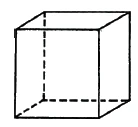 If you move the body itself, if you move a cube around in space, you will again only get a spatial body. You cannot move space out of itself.  We need to turn to a few other concepts. If you look at a straight line, it has two boundaries, two endpoints A and B (Figure 2). Let's imagine that we want A and B to touch. But if they are to touch, we have to curve the line. What happens? You cannot possibly remain within the [one-dimensional] line if you want to make A and B coincide. To connect points A and B, we have to step out of the straight line itself, we have to step out of the first dimension and into the second dimension, the plane. In this way, the straight line becomes a closed curve (that is, in the simplest case, a circle) by bringing its endpoints into alignment (Figure 3). 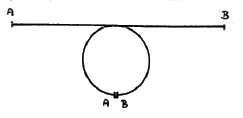 It is therefore necessary to go beyond the first dimension; you cannot remain within it. Only in this way can the circle be created. You can perform the same operation with a surface. However, this only works if you do not remain within the two dimensions. You have to enter the third dimension and then you can turn the surface into a tube, a cylinder. This operation is done in a very similar way to the way we brought two points into coincidence earlier, thereby moving out of the first dimension. Here, in order to bring two boundaries of the surface into coincidence, we have to move into the third dimension (Figure 4). 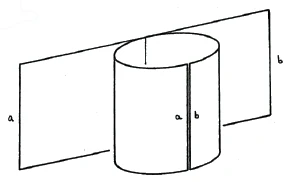 Is it conceivable that a similar operation could be carried out with a spatial structure that already has three dimensions itself? If you have two congruent cubes, you can slide one into the other. [Now imagine two congruent cubes as the boundaries of a three-dimensional prismatic body.] If you try to make one cube, which is colored red on one side [and blue on the opposite side], fit exactly over the other cube, which is otherwise [geometrically] identical but with the red and blue colors swapped, then you cannot make them fit except by rotating the cube (Figure 5). 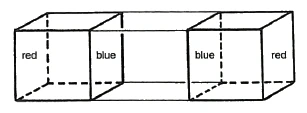 Let us consider another spatial structure. If you take the left-hand glove, it is impossible for you to pull the left-hand glove over the right hand. But if you look at the two [mirror-symmetrical] gloves together, like the straight line with the end points A and B, you have something that belongs together. It is then a single entity, with a boundary [that is, with a mirror plane] in the middle. It is very similar with the two symmetrical halves of the human outer skin. 2 How can we now make two [mirror] symmetrical three-dimensional structures coincide? Only if we go beyond the third dimension, as we did with the first and second. We can also put the right or left glove over the left or right hand, respectively, when we walk through four-dimensional space. [When constructing the third dimension (depth dimension) of the visualization space, we align the image of the right eye with that of the left eye and place it over it. We now look at an example from Zöllner. We have a circle and a point P outside of it. How can we bring the point P into the circle without crossing the circle? This is not possible if we remain within the plane. Just as one has to go from the second dimension into the third when moving from a square to a cube, we also have to go out of the second dimension here. With a sphere, there is also no possibility of entering [into the interior] without [piercing the surface of the sphere or] going beyond the third dimension. These are possibilities for thought, but they have a practical significance for the theory of knowledge, [in particular for the problem of the objectivity of the content of perception]. If we realize how we actually perceive, we will come to the following view. Let us first ask ourselves: How do we gain knowledge of bodies through our senses? We see a color. Without eyes, we would not perceive it. The physicist then says: Out there in space is not what we call color, but purely spatial forms of movement; they penetrate through our eye, are captured by the optic nerve, transmitted to the brain, and there, for example, the red arises. One may now ask: Is the red also present when there is no sensation? Red could not be perceived without the eye. The ringing of a bell could not be perceived without the ear. All our sensations depend on the transformation of forms of motion by our physical and mental apparatus. However, the matter becomes even more complicated when we ask ourselves: Where is the red, this peculiar quality, actually located? Is it in the body? Is it a process of vibration? Outside there is a process of movement, and this continues right into the eye and into the brain itself. There are vibrational [and nervous] processes everywhere, but red is nowhere to be found. Even if you examine the eye, you would not find red anywhere. It is not outside, but it is also not in the brain. We only have red when we, as a subject, confront these processes of movement. So do we have no possibility at all to talk about how the red meets the eye, how a c sharp meets the ear? The question is, what is this inner [representation], where does it arise? In the philosophical literature of the 19th century, you will find that this question runs through everything. Schopenhauer, in particular, has provided the following definition: The world is our representation. But what then remains for the external body? [Just as a color representation can be “created” by movements, so can] movement can arise in our inner self through something that is basically not moved. Let us consider twelve snapshots of a [moving] horse figure on [the inside of] a [cylinder] surface, [which is provided with twelve fine slits in the spaces between. If we look at the rotating cylinder from the side,] we will have the impression that it is always the same horse and that only its feet are moving. So [the impression of] movement can also arise through our [physical organization] when something is not moving at all [in reality]. This is how we arrive at a complete dissolution of what we call movement. But what then is matter? If you subtract color, movement [shape, etc., i.e. what is conveyed by sensory perception] from matter, then nothing remains. If we already have the [secondary, i.e. “subjective” sensations [color, sound, warmth, taste, smell] within us, we must also place [the primary sensations, that is, shape and movement,] within us, and with that the external world completely disappears. However, this results in major difficulties [for the theory of knowledge]. Let us assume that everything is outside, how then do the properties of the object outside come into us? Where is the point [where the outside merges into the inside]? If we subtract all [sensory perceptions], there is no outside anymore. In this way, epistemology puts itself in the position of Münchhausen, who wants to pull himself up by his own hair. But only if we assume that there is an outside, only then can we come to [an explanation of] the sensations inside. How can something from the outside enter our inside and appear as our imagination? We need to pose the question differently. Let us look at some analogies first. You will not be able to find a relationship [between the outside world and the sensation inside] unless you resort to the following. We return to the consideration of the straight line with endpoints A and B. We have to go beyond the first dimension, curve the line, to make the endpoints coincide (Figure 7). Now imagine the left endpoint A [of this straight line] brought together with the right endpoint B so that they touch at the bottom, so that we are able to return to the starting point [via the coinciding endpoints]. If the line is small, the corresponding circle is also small. If I turn the [initially given] line into a circle and then turn larger and larger lines into circles, the point at which the endpoints meet moves further and further away from the [original] line and goes to infinity. 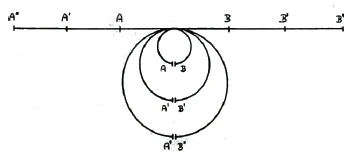 of the [original] line and goes to infinity. Only at infinity do the [increasingly large] circle lines have their endpoint. The curvature becomes weaker and weaker, and eventually we will not be able to distinguish the circle line from the straight line with the naked eye (Figure 8). 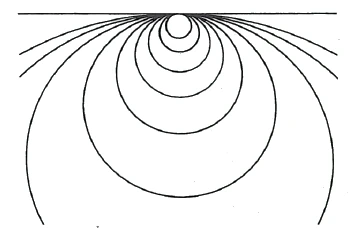 In the same way, when we walk on the Earth, it appears to us as a straight piece, although it is round. If we imagine that the two halves of the straight line extend to infinity, the circle actually coincides with the straight line. The straight line can be conceived as a circle whose diameter is infinite. Now, however, we can imagine that if we go through [the straight line and] remain within the line, we will come back from the other side of infinity. But in doing so, we have to go through infinity.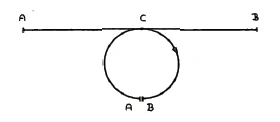 Now, instead of a [geometric] line, imagine something that is real and that connects to a reality. Let us imagine that as the point C [on the circumference of the circle] progresses, cooling occurs, that the point becomes colder and colder the further it moves away [from its starting point] (Figure 9). Let us leave the point within the circle for the time being, and, as it becomes colder and colder, let it reach the lower limit A, B. When it returns on the other side, the temperature increases again. So on the way back, the opposite condition to the one on the way there occurs. The warming increases until the temperature at C is reached again, from which we started. No matter how extended the circle is, it is always the same process: a flow of heat out and a flow of heat in. Let us also imagine this with the [infinitely extended straight] line: as the temperature [on one side increasingly] dissipates, it can rise on the other side. We have here a state that dissipates on one side while it rebuilds on the other. In this way, we bring life and movement into the world and approach what, in a higher sense, we can call an understanding of the world. We have here two states that are interdependent and interrelated. However, for everything you can observe [sensually], the process that goes, say, to the right has nothing to do with the one that comes back from the left, and yet they are mutually dependent. We now compare the body of the external world with the state of cooling and, in contrast, our inner sensation with the state of warming. [Although the external world and inner sensation have nothing directly perceptible in common,] they are related to each other, mutually dependent [in an analogous way to the processes described above]. This results in a connection between the external world [and our internal world] that we can support with an image: [through the relationship between] the seal and the sealing wax. The seal leaves behind an exact imprint, an exact reproduction of the seal in the sealing wax, without the seal remaining in the sealing wax [and without any material from the seal being transferred to the sealing wax]. So in the sealing wax there remains a faithful reproduction of the seal. It is quite the same with the connection between the outside world and inner sensations. Only the essential is transferred. One state determines the other, but nothing (material) is transferred. If we imagine that this is the case with [the connection between the] outside world and our impressions, we come to the following. [Geometric] mirror images in space behave like gloves from the left and right hand. [In order to relate these directly and continuously to each other,] we have to use a new dimension of space to help us. [Now the outside world and the inner impression behave analogously to geometric mirror images and can therefore only be directly related to each other through an additional dimension.] In order to establish a relationship between the outside world and inner impressions, we must therefore go through a fourth dimension and be in a third element. We can only seek the common ground [of the outside world and inner impressions] where we [are one] with them. [One can imagine these mirror images as] floating in a sea, within which we can align the mirror images. And so we come [initially in thought] to something that transcends three-dimensional space and yet has a reality. We must therefore bring our spatial ideas to life. Oskar Simony has tried to represent these animated spatial structures with models. [As we have seen, one comes] from the consideration of the zero-dimensional [step by step] to the possibility of imagining four-dimensional space. [On the basis of the consideration of mirror-symmetrical bodies, that is, with the help of] symmetries, we can first [most easily] recognize this space. [Another way to study the peculiarities of empirical three-dimensional space in relation to four-dimensional space is to study the knotting of curves and ribbons.] What are symmetry conditions? By intertwining spatial structures, we cause certain complications. [These complications are peculiar to three-dimensional space; they do not occur in four-dimensional spaces.] Let's do some practical thinking exercises. If we cut a band ring in the middle, we get two such rings. If we now cut a band whose ends have been twisted by 180° and then glued, we get a single twisted ring that does not disintegrate. If we twist the ends of the tape 360° before gluing them together, then when we cut it, we get two intertwined rings. Finally, if we twist the tape ends 720°, the same process results in a knot. Anyone who reflects on natural processes knows that such convolutions occur in nature; [in reality,] such intertwined spatial structures are endowed with forces. Take, for example, the movement of the Earth around the Sun, and then the movement of the Moon around the Earth. It is said that the Moon describes a circle around the Earth, but [if you look more closely] it is a line that is wrapped around [a circle, the orbit of the Earth], thus a helix around a circular line. And then we have the sun, which rushes through space so fast that the moon makes an additional spiral movement around it. So there are very complicated lines of force extending in space. We have to realize that we are dealing with complicated concepts of space that we can only grasp if we do not let them become rigid, if we have them in a fluid state. Let us recall what has been said: the zero-dimensional is the point, the one-dimensional is the line, the two-dimensional the surface and the three-dimensional the body. How do these concepts of space relate to each other? Imagine you are a creature that can only move along a straight line. What would the spatial perceptions of such a being, which itself is only one-dimensional, be like? It would not perceive its own one-dimensionality, but would only imagine points. This is because, if we want to draw something on a straight line, there are only points on the straight line. A two-dimensional being could encounter lines, and thus distinguish one-dimensional beings. A three-dimensional being, such as a cube, would perceive the two-dimensional beings. Man, then, can perceive three dimensions. If we reason correctly, we must say to ourselves: Just as a one-dimensional being can only perceive points, as a two-dimensional being can only perceive one dimension, and a three-dimensional being can only perceive two dimensions, so a being that perceives three dimensions can only be a four-dimensional being. The fact that a human being can define external beings in three dimensions, can [deal with] spaces of three dimensions, means that he must be four-dimensional. And just as a cube can only perceive two dimensions and not its third, it is true that the human being cannot perceive the fourth dimension in which he lives. |
| 324a. The Fourth Dimension (2024): Second Lecture
31 Mar 1905, Berlin Rudolf Steiner |
|---|
| 324a. The Fourth Dimension (2024): Second Lecture
31 Mar 1905, Berlin Rudolf Steiner |
|---|
Today I want to discuss some elementary aspects of the idea of multidimensional space [among other things, in connection with the] spirited Hinton. You will recall how we arrived at the concept of multi-dimensional space, having considered the zeroth dimension [last time]. I would like to briefly repeat the ideas of how we can move from two- to three-dimensional space. What do we mean by a symmetrical behavior? How do I align a red and a blue [flat figure, which are mirror images of each other]? 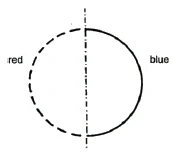 With two halves of a circle, I can do this relatively easily by sliding the red [half] circle into the blue one (Figure 10). This is not so easy in the following [mirror]symmetrical figure (Figure 11). I cannot make the red and blue parts coincide [in the plane], no matter how I try to slide the red into the blue. 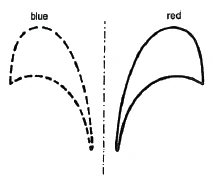 But there is a way [to achieve this anyway]: if you step out of the board, that is, out of the second dimension [and use the third dimension, in other words, if you] place the blue figure on the red one [by rotating it through the space around the mirror axis]. The same applies to a pair of gloves: I cannot match one with the other without stepping out of [three-dimensional] space. You have to go through the fourth dimension. Last time I said that in order to develop an understanding of the fourth dimension, you have to make [the relationships in] space fluid, thereby creating conditions similar to those you have when moving from the second to the third dimension. In the last lesson, we created spatial structures out of paper strips that intertwined. Such interweaving causes certain complications. This is not a game, but such inter-weavings occur in nature all the time. Anyone who reflects on natural processes knows that such inter-weavings really do occur in nature. Material bodies move in such intertwined spatial structures. These movements are endowed with forces, so that the forces also intertwine. Take the movement of the earth around the sun and then the movement of the moon around the earth. The moon moves in an orbit that is itself wound around the earth's orbit around the sun. It thus describes a spiral around a circular line. Because of the movement of the sun, the moon describes another spiral around this. The result is very complicated lines of force that extend through the whole space. The heavenly bodies behave in relation to each other like the intertwined strips of paper [by Simony, which we looked at last time]. We have to keep in mind that we are dealing with complicated spatial concepts that we can only understand if we do not let them become rigid. If we want to grasp space [in its essence], [we must first conceive it as rigid, but then] make it completely fluid again. [You have to go as far as zero]; the [living] point can be found in it. Let us once again visualize the structure of the dimensions]. The point is zero-dimensional, the line is one-dimensional, the surface is two-dimensional and the body is three-dimensional. The cube has the three dimensions: height, width and depth. How do the spatial structures [of different dimensions] relate to each other? Imagine that you are a straight line, that you have only one dimension, that you can only move along a straight line. If such beings existed, what would their concept of space be like? Such beings would not perceive one-dimensionality in themselves, but would only be able to imagine points wherever they went. Because in a straight line, if we want to draw something in it, there are only points. A two-dimensional being would only encounter lines, so it would only perceive one-dimensional beings. [A three-dimensional being like] the cube would perceive two-dimensional beings, but could not perceive its [own] three dimensions. Now, humans can perceive their three dimensions. If we reason correctly, we must say to ourselves: Just as a one-dimensional being can only perceive points, a two-dimensional being only straight lines, and a three-dimensional being only surfaces, so a being that perceives three dimensions must itself be a four-dimensional being. The fact that humans can define external beings in terms of three dimensions, can [deal with] spaces of three dimensions, means that they must be four-dimensional. And just as a cube can perceive only two dimensions and not its third, so it is clear that man cannot perceive the fourth dimension in which he lives. Thus we have shown [that man must be a four-dimensional being]. We swim in the sea [of the fourth dimension, like ice in water]. Let us return once more to the consideration of mirror images (Figure 11). This vertical line represents the cross-section of a mirror. The mirror reflects an image [of the figure on the left]. The process of reflection points beyond the two dimensions into the third dimension. [To understand the direct and continuous connection between the mirror image and the original, we have to add a third dimension to the two. 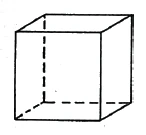 [Now let us consider the relationship between external space and internal representation.] The cube here apart from me [appears as] an idea in me (Figure 12). The idea [of the cube] is related to the cube like a' mirror image to the original. Our sensory apparatus [creates an imagined image of the cube. If you want to align this with the original cube, you have to go through the fourth dimension. Just as the third dimension has to be transitioned to (during the continuous execution of the two-dimensional) mirroring process, our sensory apparatus has to be four-dimensional if it is to be able to establish a [direct] connection [between the imagined image and the external object]. If you only imagined [two-dimensionally], you would [only] have a dream image in front of you, but you would have no idea that there is an object outside. Our imagination is a direct inversion of our ability to imagine [external objects by means of] four-dimensional space. The human being in the astral state [during earlier stages of human evolution] was only a dreamer, he had only such ascending dream images.” He then passed from the astral realm to physical space. Thus we have mathematically defined the transition from the astral to the [physical-] material being. Before this transition occurred, the astral human being was a three-dimensional being and therefore could not extend his [two-dimensional] ideas to the objective [three-dimensional physical-material] world. But when he [himself] became physical-material, he still acquired the fourth dimension [and could therefore also experience three-dimensionally]. Due to the peculiar design of our sensory apparatus, we are able to align our perceptions with external objects. By relating our perceptions to external things, we pass through four-dimensional space, imposing the perception on the external object. How would things appear if we could see from the other side, if we could enter into things and see them from there? To do that, we would have to pass through the fourth dimension. The astral world itself is not a world of four dimensions. But the astral world together with its reflection in the physical world is four-dimensional. Anyone who is able to see the astral world and the physical world at the same time lives in four-dimensional space. The relationship of our physical world to the astral world is a four-dimensional one. One must learn to understand the difference between a point and a sphere. In reality, this point would not be passive, but a point radiating light in all directions (Figure 13). 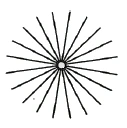 What would be the opposite of such a point? Just as there is an opposite to a line that goes from left to right, namely a line that goes from right to left, there is also an opposite to the point. We imagine an enormous sphere, in reality of infinite size, that radiates darkness from all sides, but now inwards (Figure 14). This sphere is the opposite of the point. 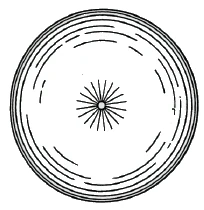 These are two real opposites: the point radiating light and infinite space, which is not a neutral dark entity, but one that floods space with darkness from all sides. [As a contrast, this results in] a source of darkness and a source of light. We know that a straight line that extends to infinity returns to the same point from the other side. Likewise, it is with a point that radiates light in all directions. This light comes back [from infinity] as its opposite, as darkness. Now let us consider the opposite case. Take the point as the source of darkness. The opposite is a space that radiates light from all sides. As was recently demonstrated [in the previous lecture], the point behaves in this way; it does not disappear [into infinity, it returns from the other side] (Figure 15).  [Similarly, when a point expands or radiates out, it does not lose itself in infinity; it returns from infinity as a sphere.] The sphere, the spherical, is the opposite of the point. Space lives in the point. The point is the opposite of space. What is the opposite of a cube? Nothing other than the whole of infinite space, except for the piece that is cut out here [by the cube]. So we have to imagine the [total] cube as infinite space plus its opposite. We cannot do without polarities if we want to imagine the world as powerfully dynamic. [Only in this way] do we have things in their life. If the occultist were to imagine the cube as red, the space around it would be green, because red is the complementary color of green. The occultist not only has simple ideas for himself, he has vivid ideas, not abstract, dead ideas. The occultist must enter into things from within himself. Our ideas are dead, while the things in the world are alive. We do not live with our abstract ideas in the things themselves. So we have to imagine the infinite space in the corresponding complementary color to the radiating star. By doing such exercises, you can train your thinking and gain confidence in how to imagine dimensions. You know that the square is a two-dimensional spatial quantity. A square composed of four red- and blue-shaded sub-squares is a surface that radiates differently in different directions (Figure 16). The ability to radiate differently in different directions is a three-dimensional ability. So here we have the three dimensions of length, width and radiance. 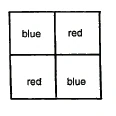 What we did here with the surface, we also think of as being done for the cube. Just as the square above was made up of four sub-squares, we can imagine the cube as being made up of eight sub-cubes (Figure 17). This initially gives us the three dimensions of height, width and depth. Within each sub-cube, we can then distinguish a specific light-emitting capacity, which results in a further dimension in addition to height, width and depth: the radiation capacity. 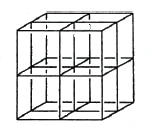 You can imagine a square made up of four sub-squares, a cube made up of eight different sub-cubes. And now imagine a body that is not a cube, but has a fourth dimension. We have created the possibility of understanding this through radiative capacity. If each [of the eight partial cubes] has a different radiating power, then if I have only the one cube that radiates only in one direction, if I want to obtain the cube that radiates in all directions, I have to add another one on the left, doubling it with an opposite one, I have to put it together out of 16 cubes. Next lesson we will have the opportunity to consider how we can think of a multidimensional space. |
| 324a. The Fourth Dimension (2024): Third Lecture
17 May 1905, Berlin Rudolf Steiner |
|---|
| 324a. The Fourth Dimension (2024): Third Lecture
17 May 1905, Berlin Rudolf Steiner |
|---|
My dear friends, today I will continue with the difficult chapter we have undertaken to take on. In doing so, it will be necessary to refer to the various things that I have already mentioned in the last two lectures. Then today I would also like to create the basic lines and basic concepts in order to [the more exact geometrical relationships as well as] the interesting practical aspects of theosophy, to make them our own. You know that we have tried to imagine four-dimensional space in its potentiality for the very reason that we can at least create some kind of concept about the so-called astral realm as well as about the higher realms, about higher existence in general. I have already indicated that entering the astral space, the astral world, is initially something tremendously confusing for the secret disciple. For those who have not studied these things in detail, who have not even studied them theoretically, who have not even studied Theosophy theoretically, it is extremely difficult to even begin to form an idea of the very different nature of the things and entities that confront us in the so-called astral world. Let us once again point out how great this diversity is. As the simplest thing, I mentioned that we have to learn to read every number symmetrically. The secret student, who is only accustomed to reading numbers as they are read here in the physical world, will not be able to find his way through the labyrinth of the astral. If you have a number in the astral, for example 467, you have to read it as 764. You have to get used to reading everything symmetrically, to seeing everything symmetrically (in a mirror image). That is the basic condition. This is still easy as long as we are dealing with spatial structures or numbers. It becomes more difficult when we come to time relationships. When we come to time relationships, the matter also becomes symmetrical in the astral, in such a way that what comes later appears to us first and what comes earlier appears later. So when you observe astral processes, you also have to be able to read backwards from front to back. These things can only be hinted at, because they sometimes seem quite grotesque to those who have never had an idea of them. In the astral, the son is there first and then the father; in the physical, the egg is there first and then the chicken. In the physical, it is different. In the physical, birth comes first, and then the birth is an emergence of a new thing from an old one. In the astral, it is the other way around. There, the old emerges from the new. In the astral, what is paternal or maternal nature devours what is filial or daughterly nature for the appearance. In Greek, you have a pretty allegory. The three gods Uranus, Kronos and Zeus symbolize the three worlds. Uranus represents the heavenly world: Devachan; Kronos represents the astral; Zeus the physical. Kronos is said to devour his children.” So in the astral, one does not give birth, but is consumed. But things get very complicated when we look at the moral aspect of the astral plane. This also appears in a kind of reversal or mirror image. And that is why you can imagine how differently things appear when we interpret things as we are accustomed to interpreting them in the physical. In the astral, for example, we see a wild animal approaching us. This is not to be understood in the same way as in the physical. The wild animal is choking us. This is the appearance that someone who is accustomed to reading things in the same way as external events has. But the wild animal is in truth something that exists within ourselves, that lives in our own astral body and that is choking us. What approaches you as a strangler is rooted in your own desire. So you can experience that when you have a thought of revenge, this thought of revenge appears to you as a strangling angel that approaches you from outside and harasses you. In truth, everything radiates from us [in the astral realm]. We must regard everything that we see approaching us in the astral as emanating from us (Figure 18). It comes from the sphere, from all sides, as if from infinite space, it penetrates into us. But in reality it is nothing other than what our own astral body sends out. 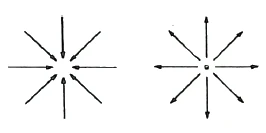 We only really read the astral [and only then] find the truth when we are able to bring the peripheral into the center, to see and interpret the peripheral as the central. The astral seems to come at you from all sides. Think of it this way: in reality, it is something that radiates out from you in all directions. I would like to familiarize you with a term that is very important in occult training. It appears in a wide variety of works on occult research, but is rarely understood correctly. Those who have reached a certain level of occult development must learn to see everything that is still karmically predisposed in them – joy, lust, pain, and so on – in the astral outside world. If you think theosophically in the right sense, you will realize that the outer life, our body, in the present age is nothing more than a result, an average of two currents coming from opposite directions and merging into each other . Imagine a current coming from the past and one coming from the future, and you have two currents that merge and actually intersect at every point (Figure 19). Imagine a red current in one direction and a blue current in the other direction. And now imagine, for example, four different points in this intersection. [Then, at each of these four points, we have] an interaction of these red and blue currents. [This is an image for the interaction of] four successive incarnations, where in each incarnation something comes towards us from one side [and something from the other]. You can always say to yourself, there is a current that comes towards you and a current that you bring with you. Man flows together out of these two currents.  You get an idea of it if you think of it this way. Today you sit here with different experiences, tomorrow at the same hour you will have a different set of events around you. Imagine the events that you will have by tomorrow are already all there. It would then be the same experience as if you were looking at a panorama. It would be as if you were approaching these events, as if these events were coming towards you spatially. So imagine that the stream that is coming towards you from the future brings you these events, then you have the events between today and tomorrow in this stream. You allow the future flowing towards you to be carried by the past. In every period of time, your life is an intersection of two currents, one from the future to the present and the other from the present to the future. Where the currents meet, a congestion occurs. Everything that a person still has ahead of him must be seen emerging as an astral phenomenon. This is something that speaks an incredibly impressive language. Imagine that the secret disciple [comes to the point in his development where he] is supposed to look into the astral world, where the senses are opened to him so that he would see emerging around him as outer phenomena in the astral world that which he would still have to experience before the end of the present period. This is a sight that is very powerful for every human being. We must therefore say that it is an important step in the course of occult training for the human being to be confronted with the astral panorama, the astral phenomenon, of what he still has to experience until the middle of the sixth root race, because that is how long our incarnations will last. The path opens up before him. No secret disciple will experience it differently, except that he sees as an external phenomenon what he still has to face in the near future up to the sixth root race. When the disciple has advanced to the threshold, the question arises: Do you want to live through all this in the shortest conceivable time? Because that is what it is about for the one who wants to receive the initiation. If you think about it, you have your own future life in front of you as an external panorama in a moment. That, in turn, is what characterizes our view of the astral. For one person, it is something that makes them say, “No, I'm not going in there.” For another, on the other hand, it is something that makes them say, “I have to go in there.” This point in the process of development is called the 'threshold', the decision, and the phenomenon that one has there, oneself with everything that one still has to experience and live through, is called the 'guardian of the threshold'. The guardian of the threshold is therefore nothing other than our own future life. It is ourselves. Our own future life lies behind the threshold. You see in this another peculiarity of the astral world of appearance, namely, that when the astral world is suddenly opened to someone through some event – and such events do occur in life – that person must first face something incomprehensible. It is a terrible sight, which could not be more confusing for those people upon whom, unprepared, the astral world suddenly breaks in through some event. It is therefore eminently good to know what we have now discussed, so that in the event of the astral world breaking in, one knows what to do. It may be a pathological event, a loosening between the physical body and the etheric body or between the etheric body and the astral body. Through such events, a person may be unexpectedly transported into the astral world and gain insights into astral life. If this happens, the person will come and say that he sees this or that apparition. He sees it and does not know how to read it, because he does not know that he has to read symmetrically, that he has to understand every wild animal that approaches him as a reflection of what lies within himself. Indeed, the astral powers and passions of man appear in Kamaloka in the most diverse forms of the animal world. It is not a particularly beautiful sight to see people in Kamaloka who have just been reaped. At that moment they still have all their passions, urges, desires and cravings. Such a person in Kamaloka no longer has his physical body or etheric body, but in his astral body he still has everything that connected him to the physical world, that can only be satisfied through the physical body. Imagine an average citizen of the present day who has achieved nothing special in his past life and has not made any effort to achieve anything, who has never done much for his religious development, who may not have abandoned religion in theory, but practically, that is, in his feelings and attitudes, has thrown it overboard. In that case it is not a living element in him. What then is in his astral body? There are only things that can be satisfied through the physical organism. For example, he craves palate enjoyment. But the palate would have to be there for that, so that this desire can be satisfied. Or man craves for other pleasures, which can only be satisfied by setting his physical body in motion. Suppose he had such a craving, but the body was gone. Then all this lives in his astral body. This is the situation in which man finds himself when he has died without astral purification and cleansing. He still has the desire for the pleasures of the palate and the other things, but not the possibility of satisfying them. This is what causes the torment and horror of the life in Kamaloka. Therefore, the desire must be laid aside in Kamaloka if man dies without astral purification. Only when this astral body has learned that it can no longer satisfy its desires and wishes, that it must unlearn them, is it freed. [In the astral world] the instincts and passions take on animal forms. As long as the person is embodied in the physical body, the shape of their astral body is somewhat based on this physical body. But when the outer body is gone, then the instincts, desires and passions, as they are in their animal [nature], come into their own in their own form. So in the astral world, a person is an image of their instincts and passions. Because these astral beings can make use of other bodies, it is dangerous to let mediums enter into a trance when there is no clairvoyant is present to avert evil. In the physical world, the lion is a plastic expression of certain passions, the tiger is an expression of other passions, and the cat is an expression of yet other passions. It is interesting to see how each animal is the plastic expression of a passion, of an urge. In the astral, in Kamaloka, man is therefore approximately similar to [animal nature] through his passions. This is the source of the misunderstanding regarding the doctrine of transmigration of souls that has been attributed to Egyptian and Indian priests and teachers of wisdom. You should live in such a way that you do not incarnate as an animal, says this teaching. But this teaching never speaks of the physical life, but of the higher life, and its only aim was to persuade people on earth to lead such a life that after death in Kamaloka they would not have to develop their animal form. Those who develop the characteristics of a cat will appear in Kamaloka as a cat. The fact that one also appears as a human being in Kamaloka is the meaning of the rules of the doctrine of the transmigration of souls. The true teachings have not been understood by the scholars; they only have an absurd idea of them. Thus we have to deal with a complete mirror image of what we actually think and do here in the physical world in every area – in the areas of number, time and moral life – when we enter the astral realm. We must get used to reading symmetrically, because we must be able to do so when we enter the astral space. The easiest way for a person to get used to reading symmetrically is to build on such elementary mathematical ideas as we have hinted at in the previous lecture and as we will get to know more and more in the following discussions. I would like to start with a very simple idea, namely the idea of a square. Imagine a square as you are accustomed to seeing it (Figure 20). I will draw the square so that the four sides are drawn in four different colors.  This is the physical appearance of the square. Now I would like to draw the devachan aspect of the square on the board. It is not possible to do this exactly, but I would like to give you an approximate idea of what a square would look like in the mind. The mental counter-image [of a square] is approximately like a cross (Figure 21). 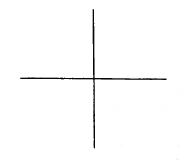 We are dealing here mainly with two perpendicular intersecting axes. Two lines that pass through each other, and that's it. The physical counter-image is created by drawing perpendicular lines on each of these axes. The physical counter-image of a mental square can best be imagined as a congestion [of two mutually intersecting currents]. Let us imagine these perpendicular axis lines as currents, as forces that act outwards from the point of intersection, and let us imagine countercurrents to these currents, only now in the direction from outside to inside (Figure 22). A square then enters into the physical world by imagining these two types of currents or forces - one from the inside, the other from the outside - as accumulating against each other. The currents of force are thus limited by accumulations. 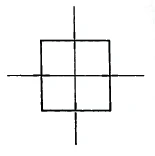 With this, I have given a picture of how everything mental relates to the physical. Likewise, you can construct the mental counterpart for any physical thing. The square here is only the simplest of examples. If you could construct a correlative for every physical thing that corresponds to the physical world in the same way that two perpendicular lines correspond to a square, then you would obtain the devachan or mental image for every physical thing. With other things, it is of course much more complicated. Now imagine a cube instead of a square. The cube is very similar to the square. The cube is a body that is bounded by six squares. Mr. Schouten made these six squares that bound the cube specially. Now, instead of the four bounding lines that are present in the square, imagine six bounding surfaces. Imagine that instead of vertical lines we have vertical surfaces as a kind of congestion, and then assume that you have not two but three axes standing on one another [vertically], and you have the boundary of the cube. Now you can also imagine what the mental correlate of the cube is. You have again two things that challenge each other reciprocally. The cube has three perpendicular axes and three surface directions; we have to think of congestion effects in these three surface directions (Figure 23). We cannot imagine the three axes and the six surfaces, as before the two axes and four lines, in any other relationship than by thinking of a certain contrast. 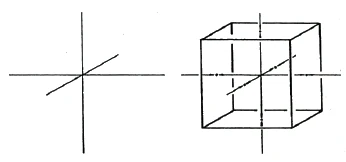 Anyone who reflects on this will have to admit that we cannot imagine this without forming a certain concept of the opposition, namely the opposition of activity and an obstruction, a counter-activity. You have to introduce the concept of opposition here. The matter is still simple here. By entwining ourselves around geometric concepts, we will be able to construct the mental counter-images of more complicated things in an appropriate way. Then we will find the way and to some extent reach higher knowledge. But you can already imagine the colossal complexity that arises when you think of another body and look for its mental counter-image. Many complicated things come to light. And if you were to imagine another person and their mental counterpart, with all their spatial forms and their activity, you can imagine the complicated mental structure that this produces. In my book 'Theosophy', I was only able to give a rough idea of what mental counter-images look like. We have three dimensions, three axes in the cube. On each axis we have the corresponding perpendicular planes on both sides. So you must now be clear about the fact that the contrast I have spoken of is to be understood in such a way that you imagine each face of the cube as having come into being in a way similar to the way I described human life earlier, as the intersection of two currents. You can imagine currents emanating from the center point. Imagine space in one axial direction, flowing outwards from the center, and in the other direction, flowing in from infinity, another current. And this [imagine] flowing in two colors, one red, the other blue. At the moment they meet, they will flow into a surface, a surface will arise, so that we can assume the surface of the cube to be the meeting point of two opposing currents in a surface. This gives a vivid idea of what a cube is. The cube is therefore an intersection of three currents acting on each other. If you think about it, you are not dealing with three, but with six directions: forward-backward, up-down, right-left. So you have six directions. And indeed, that is the case. Then the matter becomes even more complicated by the fact that you have two types of currents: One in the direction of a point, the other coming from infinity. This will give you a perspective on the practical application of the higher, theoretical theosophy. I have conceived every direction in space as two opposing currents. And if you then imagine a physical body, then you have in that physical body the result of these two currents running into each other. Let us now denote these six currents, these six directions, with six letters a, b, c, d, e, f. If you could visualize these six directions or currents — we will come to being able to do this next time — and you would imagine the first and last, a and f, erased, then you would be left with four. And that is what I now ask you to take into account: these four that remain are the four that you can perceive when you see the astral world alone. I have tried to give you an idea of the three [ordinary dimensions] and of three [further] dimensions that actually behave in the opposite way. It is through the interaction of these dimensions and their counteraction that physical bodies arise. But if you think a little way away from the physical [dimension] and a little way away from the mental on the other side, you are left with four dimensions. These then represent the astral world existing between the physical and mental worlds. The theosophist's view of the world is such that it necessarily has to work with a higher sense of geometry that goes beyond ordinary geometry. The ordinary geometer describes the cube as bounded by six squares. We must understand the cube as the result of six currents running into each other, that is, as the result of a movement and its reversal, of the interaction of opposing forces. I would like to show you another such concept outside in nature, where a real contrast has taken place that contains a deep secret of the world's development before the eyes of man. In the “Fairytale of the Snake and the Lily”, Goethe speaks of the “revealed secret”, and that is one of the truest and wisest words that can be spoken at all. It is true, there are secrets in nature that can be grasped with hands, but are not seen by people. We are dealing with reversal processes in nature in many cases. I would like to show you one such reversal process. Let us compare humans with plants. When compared to plants, humans behave as follows. What I am about to say is not a game, even if it initially seems like one. It is something that points to a deep mystery. What does a plant have in the ground? Its roots. And upwards it develops stems, leaves, flowers and fruit. The main part of the plant, the root, is in the earth, and the organs of reproduction it develops upwards, towards the sun, which we can call the chaste way of reproducing. Imagine the whole plant turned upside down, with the root becoming the head of a human being. Then you have the opposite of the plant in the human being, who has his head at the top and his reproductive organs at the bottom. And the animal is in the middle of it all, as a stowage. If you turn the plant upside down, you get a human being. That is why the occultists of all times draw this with three lines (Figure 24). 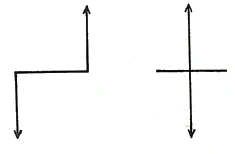 One [line] as the symbol of the plant, one as the [symbol] of the human being, and one in the opposite direction as the [symbol] of the animal – three lines that together form the cross. The animal has the transverse position, it thus crosses what we have in common with the plant. You know that we speak of an all-soul, of which Plato says that it is crucified to the cosmic body, that it is chained to the cross of the cosmic body.? Imagine the world soul as plant, animal and human being, and you have the cross. By living in these three realms, the world soul is chained to this cross. As a result, you will find the concept of congestion expanded. You will find it expanded by something in nature. Two complementary, diverging, but interlocking currents form plants and humans, with congestion being the animal. Thus, the animal actually places itself between an upward and a downward current. In this way, the Kamaloka [astral sphere] interposes itself between Devachan and the physical world. Thus, something interposes itself between these two symmetrical worlds, between Devachan and the physical world, and acts between them, acting on both sides like a dam. The outer expression of this Kamaloka world is the animal world. Those who already have organs for this world, which must be grasped with strength, will recognize what we see in the three kingdoms in their mutual relationship to one another. If you understand the animal kingdom as emerging from a congestion, if you understand the three kingdoms as mutual congestion, then you will find the position that the plant kingdom has to the animal kingdom and the animal kingdom to the human kingdom. The animal is perpendicular to the other two directions, and the other two are two complementary currents that merge into each other. The lower realm serves the higher realm as food. This is something that allows a small glimpse of the very different kind of relationship between humans and plants and between animals and humans. Those who feed on animals are therefore related to a congestion. The real effect consists in the encounter of opposing currents. This is the beginning of a series of thoughts that you may later see in a strange and very different way. We have seen that the square is created when two axes are intersected by lines. The cube is created by intersecting three axes through surfaces. Can you now imagine four axes intersecting through something? The cube is the boundary of the spatial structure that is created when four axes are intersected. The square limits the three-dimensional cube. Next time, we will see whose boundary the cube itself is. The cube bounds a four-dimensional structure. Answering Questions [What does it mean to] imagine six currents, of which two must be imagined as having been extinguished, and so on? The six currents must be thought of as two times three currents: three acting from the inside out according to the three axial directions, and the other three as flowing towards these from infinity. For each axial direction, there are thus two types, one going from the inside out, the other coming from the outside in the opposite direction. If we call the two categories positive and negative, plus and minus, we have: math figur And of this [in order to get to the astral space, we have to] imagine an entire direction, [for example the] inner and outer flow, erased, so for example +a and -a. |
| 324a. The Fourth Dimension (2024): Fourth Lecture
24 May 1905, Berlin Rudolf Steiner |
|---|
| 324a. The Fourth Dimension (2024): Fourth Lecture
24 May 1905, Berlin Rudolf Steiner |
|---|
I recently tried to give you a schematic idea of four-dimensional space. But it would be very difficult if we were not able to form a picture of four-dimensional space in some kind of analogy. If it were a matter of characterizing our task, then it would be this: to show a four-dimensional structure here in three-dimensional space. Initially, we only have three-dimensional space at our disposal. If we want to link something unknown to us with something known, then, just as we have mapped a three-dimensional object into two dimensions, we have to bring a four-dimensional object into the third dimension. Now I would like to show, in the most popular way possible, using Mr. Hinton's method, how four-dimensional space can be mapped within three dimensions. So I would like to show how this task can be solved. First, let me assume how to bring three-dimensional space into two-dimensional space. Our blackboard here is a two-dimensional space. If we were to add depth to height and width, we would have three-dimensional space. Now let's try to visualize a three-dimensional object on the blackboard. A cube is a three-dimensional object because it has height, width and depth. Let's try to bring it into two-dimensional space, or onto a plane. If you take the whole cube and roll it up, or rather unroll it, you can do it like this. The sides, the six squares that we have in three-dimensional space, can be spread out once in a plane (Figure 25). So I could imagine the boundary surfaces of the cube spread out on a plane in a cross shape. 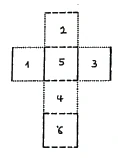 There are six squares that can be rearranged to form a cube again if I fold them back, so that squares 1 and 3, 2 and 4, and 5 and 6 are opposite each other. Thus we have a three-dimensional structure simply laid in the plane. This is not a method that we can use directly to draw the fourth dimension in three-dimensional space. For that, we have to look for a different analogy. We have to use colors to help us. To do that, I will label the six squares along their sides with different colors. The squares facing each other [in the cube] should have the same colors when they are unfolded. I will draw the squares 1 and 3 so that one side is red [dotted lines] and the other is blue [solid lines]. Now I will complete these squares so that I keep blue for the whole horizontal direction (Figure 26). So I will draw all the vertical sides of these squares in red and all the horizontal sides in blue. 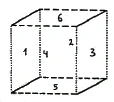 If you look at these two squares, 1 and 3, you have the two dimensions that the squares have, expressed in two colors, red and blue. So here for us [at the vertical blackboard, where square 2 is “stuck” to the blackboard], red would mean height and blue depth. Let us now keep in mind that we apply red wherever height occurs and blue wherever depth occurs; and then we want to take green [dashed line] for the third dimension, width. Now we want to complete the unfolded cube in this way. The square 5 has sides that are blue and green, so the square 6 must look the same. Now only the squares 2 and 4 remain, and if you imagine them unfolded, it follows that the sides will be red and green. Now, if you imagine it, you will see that we have transformed the three dimensions into three colors. We now say red [dotted], green [dashed], and blue [(solid line)] for height, width, and depth. We name the three colors that are to be images for us instead of the three spatial dimensions. If you imagine the whole cube opened up, you can explain the third dimension in two dimensions in such a way as if, for example, you had let the blue-red square [from left to right in Figure 26] march through green. We want to say that red and blue passed through green. We will describe the marching through green, the disappearance into the third color dimension, as the passage through the third dimension. So, if you imagine that the green fog colors the red-blue square, both sides – red and blue – will appear colored. Blue will take on a blue-green hue and red a cloudy shade, and only where the green stops will both appear in their own color again. I could do the same with squares 2 and 4. So I let the red-green square move through a space that is blue, and then you can do the same with the other two squares, 5 and 6, where the blue-green square would have to pass through the red. In this way, you let each square disappear on one side, submerging it in a different color. It takes on a different color itself through this third color, until it emerges on the other side in its original state. We thus have an allegorical representation of our cube using three perpendicular colors. We have simply used three colors to represent the three directions we are dealing with here. If we want to imagine the changes that the three pairs of squares have undergone, we can do so by imagining that the squares pass through green the first time, red the second time, and blue the third time. Now imagine squares instead of these [colored] lines, and squares everywhere for the bare space. Then I can draw the whole figure differently (Figure 27). We draw the transit square blue, and the two that pass through it – before and after the transit – we draw them above and below, here in red-green. [In a second step] I take the red square as the one that allows the blue-green squares to pass through it. And [in a third step] we have the green square here. The two corresponding other colors, red and blue, pass through the green square. You see, now I have shown you another form of propagation with nine adjacent squares, but only six of which are on the cube itself, namely the squares drawn at the top and bottom of the figure (Figure 27). The other three [middle] squares are transition squares that denote nothing more than the disappearance of the individual colors into a third [color]. [For the transition movement, we] therefore always have to take two dimensions together, because each of these squares [in the upper and lower rows] is composed of two colors and disappears into the color that it does not contain itself. To make these squares reappear on the other side, we let them disappear into the third color. Red and blue disappear into green, red and green have no blue, so they disappear into blue [and green and blue disappear into red]. 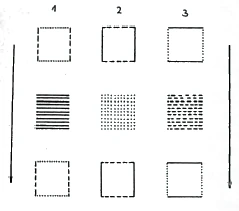 So, you see, we have the option here of assembling our cube using squares from two color dimensions that pass through the third color dimension. Now it stands to reason that we imagine cubes instead of squares, and in doing so we put the cubes together out of three color dimensions – just as we put the square together out of two lines of different colors – so that we have three colors, according to the three dimensions of space. If we now want to do the same as we did with the square, we have to add a fourth color. This will allow us to make the cube disappear as well, of course only through a color that it does not have itself. Instead of the three pass squares, we now have four pass cubes in four colors: blue, white, green, and red. So instead of the pass square, we have the pass cube. Mr. Schouten has now produced these colored cubes in his models. Now, just as we have a square pass through another that is not its color, we must now let a cube pass through another that is not its color. So we let the white-red-green cube pass through a blue one. It will submerge into the fourth color on one side and reappear in its [original] colors on the other side (Figure 28.1). 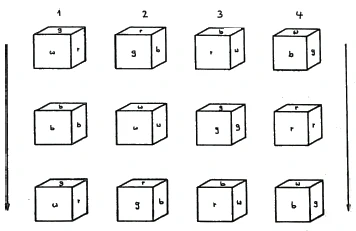 So here we have a [color] dimension bounded by two cubes that have three colored faces. In the same way, we now have to let the green-blue-red cube pass through the white cube (Figure 28.2), and then let the blue-white-red cube pass through the green (Figure 28.3). In the last figure (Figure 28.4), we have a blue-green-white cube that has to pass through a red dimension, that is, it has to disappear into a color that it does not itself have, in order to reappear on the other side in its very own colors. These four cubes behave exactly like our three squares did before. If you now realize that we need six squares to bound a cube, we need eight cubes to bound a four-dimensional object, the tessaract. Just as we obtained three auxiliary squares there, which only signify their disappearance through the other dimension, so here we obtain twelve cubes in all, which are related to each other in the same way that these nine figures are related in the plane. Then we did the same with the cube as we did earlier with the squares, and by choosing a new color each time, a new dimension was added to the others. So we think, we represent a body that has four dimensions in color, in that we have four different colors in four directions, with each [single] cube having three colors and passing through the fourth [color].The purpose of this substitution of dimensions with colors is that, as long as we stick with the [three] dimensions, we cannot bring the three dimensions into the [two-dimensional] plane. But if we use three colors instead, we can do it. We do the same with four dimensions if we want to visualize them using [four] colors in three-dimensional space. This is one way in which I would like to introduce you to these otherwise complicated things, and how Hinton used them in his problem [of the three-dimensional representation of four-dimensional structures]. I would now like to spread out the cube in the plane again, to turn it over into the plane once more. I will draw this on the board. First, disregard the bottom square [of Figure 25] and imagine that you can only see two-dimensionally, so you can only see what is spread out on the surface of the board. If we put five squares together as in this case, so that they are arranged in such a way that the one square comes into the middle, this inner area remains invisible (Figure 29). You can go around it from all sides. You cannot see square 5 because you can only see in two dimensions. 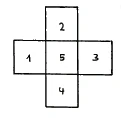 Now let us do the same thing that we have done here with five of the six side squares of the cube with seven of the eight boundary cubes that form the tessaract when we spread our four-dimensional structure into space. I will lay out the seven cubes in the same way as I did with the faces of the cube on the board; only now we have cubes where we previously had squares. Now we have here the corresponding spatial figure, formed entirely analogously. Thus we have the same for three-dimensional space as we previously had for two-dimensional surface. Just as a square is completely hidden from all sides, so is the seventh cube, which a being that has [only] the ability to see three-dimensionally will never be able to see (Figure 30). If we could fold up these figures in the same way as the six unfolded squares of the cube, we could pass from the third into the fourth dimension. We have shown how one can form an idea of this by means of color transitions." 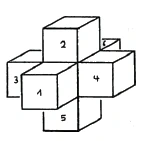 With this, we have at least shown how, despite the fact that humans can only perceive three dimensions, we can still imagine four-dimensional space. Now you might still wonder how one can gain a possible conception of the real four-dimensional space. And here I would like to point you to something that is called the actual “alchemical secret.” For the real insight into four-dimensional space is in some way connected with what the alchemists called “transformation”. [First variant:] He who wishes to acquire a true intuitive grasp of four-dimensional space must perform very definite exercises in intuitive grasp. These consist in his first forming a very clear intuitive perception, a deepened intuitive perception, not an imagination, of what is called water. Such an intuitive perception of water is not so easy to come by. One must meditate for a long time and delve very deeply into the nature of water; one must, so to speak, creep into the nature of water. The second thing is to gain an insight into the nature of light. Man is familiar with light, but only in the sense that he receives it from outside. Now, through meditation, man comes to receive the inner counter-image of outer light, to know where and from what light arises, so that he can himself bring forth and generate something like light. The yogi acquires this ability to produce and generate light through meditation. This is possible for the person who is able to have pure concepts truly meditatively present in his soul, who truly allows pure concepts to have a meditative effect on his soul, who is able to think free of sensuality. Then the light arises from the concept. Then the whole environment opens up to him as flooding light. The secret disciple must now, as it were, chemically combine the conception he has formed of water with the conception of light. The water, completely permeated by light, is a body called by the alchemists Mercury. Water plus light is called Mercury in the language of the alchemists. But this alchemical Mercury is not ordinary mercury. You will not have received the matter in this form. One must first awaken within oneself the ability to generate the light from the [dealing with the pure] concepts. Mercury is this mixture [of light] with the contemplation of water, this light-imbued water power, in whose possession one then puts oneself. That is one element of the astral world. The second [element] arises from the fact that, just as one has formed an idea of water, one forms an idea of air, that we therefore suck out the power of the air through a mental process. If you concentrate your feeling in a certain way, you create a fire through feeling. If you combine the power of the air chemically with the fire created by feeling, you get “fire air.” You know that Goethe's Faust speaks of fire air.” This is something in which the inner being of the person must participate. So one element is sucked out of a given element, the air, and the other [fire or warmth] is generated by yourself. This air plus fire was called sulfur, sulphur, luminous fire-air by the alchemists. If you now have this luminous fire air in an aqueous element, then you truly have that [astral] matter of which it says in the Bible: “And the Spirit of God hovered, or brooded, over the ‘waters’.” [The third element arises when] you draw the power from the earth and then connect it with the [spiritual forces in the] “sound”; then you have what is called the Spirit of God [here]. Therefore, it is also called “thunder”. [The acting] Spirit of God is thunder, is earth plus sound. The Spirit of God [thus hovers over the] astral matter. Those “waters” are not ordinary water, but what is actually called astral matter. This consists of four types of forces: water, air, light and fire. The arrangement of these four forces presents itself to the astral view as the four dimensions of astral space. That is how they are in reality. It looks quite different in the astral than in our world, some things that are perceived as astral are only a projection of the astral into physical space. You see, that which is astral is half subjective [that is, passively given to the subject], half water and air, because light and feeling [fire] are objective, [that is, actively brought to appearance by the subject]. Only part of what is astral can be found outside [given to the subject] and obtained from the environment. The other part must be brought about subjectively [through one's own activity]. Through conceptual and emotional powers, one gains the other [from the given] through [active] objectification. In the astral, we thus have subjective-objective elements. In devachan, there is no longer any objectivity [that is merely given to the subject]. One would have a completely subjective element there. When we speak of the astral realm, we have something that the human being must first create [out of himself]. So everything we do here is symbolic, an allegorical representation of the higher worlds, of the devachanic world, which are real in the way I have explained to you in these suggestions. What lies in these higher worlds can only be attained by developing new possibilities of perception within oneself. Man must do something himself for this. [Second text variant (Vegelahn):] Those who want to acquire a real view of four-dimensional space must do very specific visual exercises. First of all, they form a very clear, in-depth view of water. Such a view is not easy to come by; one has to delve very deeply into the nature of water; one has to, so to speak, get into the water. The second thing is to gain an insight into the nature of light. Light is something that man knows, but only in the sense that he receives it from outside. Through meditation, he can gain an inner image of light, know where light comes from and therefore produce light himself. This can be done by someone who allows pure concepts to have a real meditative effect on his soul, who has a thinking free of sensuality. Then the whole of his environment will reveal itself to him as flooding light, and now he must, as it were chemically, combine the idea he has formed of water with that of light. This water, completely permeated by light, is a body that was called “Mercury” by the alchemists. But the alchemical Mercury is not the ordinary mercury. First you have to awaken within yourself the ability to generate Merkurius from the concept of light. Merkurius, light-imbued water power, is what you then place yourself in possession of. That is the one element of the astral world. The second is created by you also forming a vivid mental image of air, then sucking out the power of the air through a spiritual process, connecting it with feeling, and you ignite the concept of “warmth”, “fire”, then you get “fire air”. So one element is sucked out, the other is produced by yourself. This - air and fire - the alchemists called “sulfur”, sulfur, luminous fire air. In the aqueous element, there you have in truth that matter of which it is said: “and the Spirit of God hovered over the waters”. The third element is “spirit-God”, which is connected to “earth” and “sound”. This is what happens when you extract the earth's forces and combine them with sound. These “waters” are not ordinary water, but what is actually called astral matter. This consists of four types of forces: water, air, light and fire. And this manifests itself as the four dimensions of astral space. You see, that which is astral is half subjective; only part of what is astral can be gained from the environment; from conceptual and emotional powers, one gains the other through objectification. In devachan, you would have a completely subjective element; there is no objectivity there. So everything we do here, the symbolic, is an allegorical representation of the devachanic world. Everything that lies in the higher worlds can only be attained by developing new views within yourself. Man must do something about it himself. |
| 324a. The Fourth Dimension (2024): Fifth Lecture
31 May 1905, Berlin Rudolf Steiner |
|---|
| 324a. The Fourth Dimension (2024): Fifth Lecture
31 May 1905, Berlin Rudolf Steiner |
|---|
Last time, we tried to get an idea of a four-dimensional space. To visualize it, we reduced it to a three-dimensional one. First, we started by transforming a three-dimensional space into a two-dimensional one. We used colors instead of dimensions. We formed the idea in such a way that a cube appeared in three colors along the three dimensions. Then we laid the boundaries of a cube on the plane, which resulted in six squares in different colors. Through the diversity of colors on the individual sides, we obtained the three different dimensions in two-dimensional space. We had three colors, and with that we had represented the three dimensions. We then imagined that we were passing a square cube into the third dimension, as if we were passing it through a colored fog and it reappeared on the other side. We imagined that we had pass squares, so that the square cubes move through these squares and are thereby tinged [with the color of the pass square]. This is how we tried to imagine the [three-dimensional] cube [by means of a two-dimensional color representation]. [For the one-dimensional representation of the] surfaces, we thus have two boundary colors and [for the two-dimensional representation of the] cube, three colors. [To represent a four-dimensional spatial structure in three-dimensional space, we must] then add a fourth boundary color. Now we have to imagine in the same way that a cube, which, analogous to our square, has two different colors as boundary sides, has three different colors in its boundary surfaces. And finally, each cube moves through another cube that has the corresponding fourth color. In doing so, we let it disappear into the fourth color dimension. So, according to Hinton's analogy, we let the respective boundary cubes pass through the new [fourth] color, which then reappears on the other side, emerging in their [original] own color. 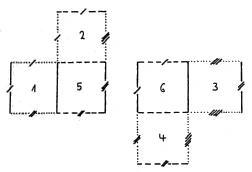 Now I will give you another analogy and first reduce the three dimensions back to two, so that we will then be able to reduce four dimensions to three. To do this, we have to imagine the following. The cube can be put together at its boundary surfaces from its six boundary squares; but instead of doing it in succession, as we did recently, it will now be done in a different way. I will also draw this figure (Figure 31). You see, we have now spread out the cube in two systems, each of which lies in the plane and consists of three squares. Now we have to be clear about how these different areas will lie when we actually put the cube together. I ask you to consider the following. If I now want to reassemble the cube from these six squares, I have to place the two sections on top of each other so that square 6 comes to rest on square 5. When square 5 is placed at the bottom, I have to fold up squares 1 and 2, while folding down squares 3 and 4 (Figure 32). In doing so, we get certain corresponding lines that overlap. The lines marked in the figure with the same color [here in the same line quality and in the same number of lines] will coincide. What lies here in the plane, in two-dimensional space, coincides to a certain extent when I move into three-dimensional space.  The square consists of four sides, the cube of six squares, and the four-dimensional area would then have to consist of eight cubes.? We call this four-dimensional area a tessaract [after Hinton]. Now, the point is that these eight cubes cannot simply be reassembled into a cube, but that one of them should always pass through the fourth dimension in the appropriate way. If I now want to do the same with the tessaract as I just did with the cube, I have to follow the same law. The point is to find analogies of the three-dimensional to the two-dimensional and then of the four-dimensional to the three-dimensional. Just as I obtained two systems of [three squares each] here, the same thing happens with the tessaract with [two systems of four cubes each] when I fold a four-dimensional tessaract into three-dimensional space. The system of eight cubes is very ingeniously devised. This structure will then look like this (Figure 33). Each time, these four cubes in three-dimensional space are to be taken exactly as these squares in two-dimensional space. 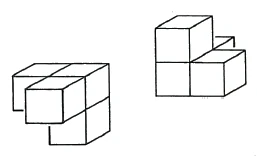 You just have to look carefully at what I have done here. When the cube was folded into two-dimensional space, a system of six squares resulted; when the corresponding procedure is carried out on the tessaract, we obtain a system of eight cubes (Figure 34). We have transferred the observation from three-dimensional space to four-dimensional space. [Folding up and joining the squares in three-dimensional space corresponds to folding up and joining the cubes in four-dimensional space.] In the case of the folded-down cube, [in the two-dimensional plane] different corresponding lines were obtained, which coincided when it was folded up again later. The same occurs with the surfaces of our individual cubes of the tessaract. [When the tessaract is folded down in three-dimensional space, corresponding surfaces appear on the corresponding cubes.] So, for example, in the case of the tessaract, the upper horizontal surface of 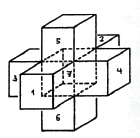 cube 1—by observing [mediation] the fourth dimension—with the front face of cube 5. In the same way, the right face of cube 1 coincides with the front square of cube 4, and likewise the left square of cube 1 with the front square of cube 3 [as well as the lower square of cube 1 with the front square of cube 6]. The same applies to the other cube surfaces. The remaining cube, 7, is enclosed by the other six. You see that here again we are concerned with finding analogies between the third and fourth dimensions. Just as a fifth square enclosed by four squares remains invisible to the being that can only see in two dimensions, as we saw in the corresponding figure of the previous lecture (Figure 29), so it is the case here with the seventh cube: it remains hidden from the three-dimensional eye. Corresponding to this seventh cube in the tessaract is an eighth cube, which, since we have a four-dimensional body here, lies as a counterpart to the seventh in the fourth dimension. All analogies lead us to prepare for the fourth dimension. Nothing forces us to add the other dimensions to the usual dimensions [within the mere spatial view]. Following Hinton, we could also think of colors here and think of cubes put together in such a way that the corresponding colors come together. It is hardly possible in any other way [than by such analogies] to give a description of how to think of a four-dimensional entity. Now I would like to mention another way [of representing four-dimensional bodies in three-dimensional space], which may also give you a better understanding of what we are actually dealing with here. This is an octahedron bounded by eight triangles, with the sides meeting at obtuse angles (Figure 35). 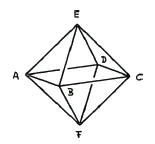 If you visualize this structure here, I ask you to follow the following procedure with me in your mind. You see, here one surface is always intersected by another. Here, for example, in AB, two side surfaces meet, and here in EB, two meet. The entire difference between an octahedron and a cube lies in the angle of intersection of the side surfaces. If surfaces intersect as they do in a cube [at right angles], a cube is formed. But if they intersect as they do here [obtuse], then an octahedron is formed. The point is that we can have surfaces intersect at the most diverse angles, and then we get the most diverse spatial structures." 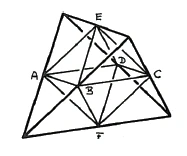 Now imagine that we could also make the same faces of the octahedron intersect in a different way. Imagine this face here, for example AEB, continued on all sides, and this lower one here, BCF, also (Figure 36). Then likewise the ADF and EDC lying backwards. Then these faces must also intersect, and in fact they intersect here in a doubly symmetrical way. If you extend these surfaces in this way, [four of the original boundary surfaces] are no longer needed: ABF, EBC and, towards the back, EAD and DCF. So of the eight surfaces, four remain. And the four that remain give this tetrahedron, which is also called half of an octahedron. It is therefore half of an octahedron because it intersects half of the faces of the octahedron. It is not the case that you cut the octahedron in half. If you bring the other four faces of the octahedron to the cut, the result is also a tetrahedron, which together with the first tetrahedron has the octahedron as a common intersection. In stereometry [geometric crystallography], it is not the part that is halved that is called the half, but the one that is created by halving the [number of] faces. With the octahedron, this is quite easy to imagine. If you imagine halving the cube in the same way, that is, if you allow one face to intersect with the corresponding other face, you will always get a cube. Half of a cube is a cube again. I would like to draw an important conclusion from this, but first I would like to use something else to help me. Here I have a rhombic dodecahedron (Figure 37). You can see that the surfaces adjoin each other at certain angles. At the same time, we can see a system of four wires, which I would like to call axial wires, and which run in opposite directions to each other [i.e. connect certain opposite corners of the rhombic dodecahedron, and are therefore diagonals]. These wires now represent a system of axes in a similar way to the way in which you imagined a system of axes on the cube. You get the cube when you create sections in a system of three perpendicular axes by introducing blockages in each of these axes. 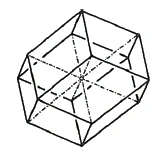 If the axes are made to intersect at other angles, a different spatial figure is obtained. The rhombic dodecahedron has axes which intersect at angles other than right angles. The cube reflects itself in half. But this applies only to the cube. The rhombic dodecahedron, cut in half, also gives a different spatial structure. 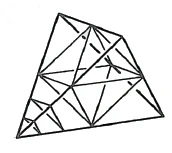 Now let us take the relation of the octahedron to the tetrahedron. And I will tell you what is meant by this. This becomes clear when we gradually let the octahedron merge into the tetrahedron. For this purpose, let us take a tetrahedron, which we cut off at one vertex (Figure 38). We continue this process until the cut surfaces meet at the edges of the tetrahedron; then what remains is the indicated octahedron. In this way we obtain an eight-sided figure from a three-dimensional figure bounded by four surfaces, provided we cut off the corners at corresponding angles. 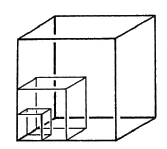 What I have done here with the tetrahedron, you cannot do with the cube. The cube has very special properties, namely that it is the counterpart of three-dimensional space. Imagine the entire universe structured in such a way that it has three perpendicular axes. If you then imagine surfaces perpendicular to these three axes, you will, under all circumstances, get a cube (Figure 39). That is why, when we speak of the cube, we mean the theoretical cube, which is the counterpart of three-dimensional space. Just as the tetrahedron is the counterpart of the octahedron when I make the sides of the octahedron into certain sections, so the single cube is the counterpart of the whole of space.” If you think of the whole of space as positive, the cube is negative. The cube is the polar opposite of the whole of space. Space has in the physical cube its actually corresponding structure. Now suppose I would not limit the [three-dimensional] space by two-dimensional planes, but I would limit it in such a way that I would have it limited by six spheres [thus by three-dimensional figures]. I first define two-dimensional space by having four circles that go inside each other [i.e., two-dimensional shapes]. You can now imagine that these four circles are getting bigger and bigger [as the radius gets longer and longer and the center point moves further and further away]; then, over time, they will all merge into a straight line (Figure 40). You then get four intersecting lines, and instead of the four circles, a square. 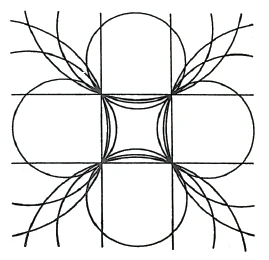 Now imagine that the circles are spheres, and that there are six of them, forming a kind of mulberry (Figure 41). If you imagine the spheres in the same way as the circles, that they get larger and larger in diameter, then these six spheres will ultimately become the boundary surfaces of a cube, just as the four circles became the boundary lines of a square. The cube has now been created from the fact that we had six spheres that have become flat. So the cube is nothing more than a special case of six interlocking spheres – just as the square is nothing more than a special case of four interlocking circles. 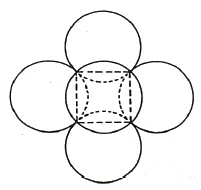 If you are clear in your mind about how to imagine these six spheres, that they correspond to our earlier squares when brought into the plane, and if you imagine an absolutely round shape passing into a straight one, you will get the simplest spatial form. The cube can be imagined as the flattening of six spheres pushed into each other. You can say of a point on a circle that it must pass through the second dimension if it is to come to another point on the circle. But if you have made the circle so large that it forms a straight line, then every point on the circle can come to every other point on the circle through the first dimension. We are considering a square bounded by figures, each of which has two dimensions. As long as each of the four boundary figures is a circle, it is therefore two-dimensional. Each boundary figure, when it has become a straight line, is one-dimensional. Each boundary surface of a cube is formed from a three-dimensional structure in such a way that each of the six boundary spheres has one dimension removed. Such a boundary surface has therefore been created by the third dimension being reduced to two, so to speak bent back. It has therefore lost a dimension. The second dimension was created by losing the dimension of depth. One could therefore imagine that each spatial dimension was created by losing a corresponding higher dimension. Just as we obtain a three-dimensional figure with two-dimensional boundaries when we reduce three-dimensional boundary figures to two-dimensional ones, so you must conclude that when we look at three-dimensional space, we have to think of each direction as being flattened out, and indeed flattened out from an infinite circle; so that if you could progress in one direction, you would come back from the other. Thus, each [ordinary] spatial dimension has come about through the loss of the corresponding other [dimension]. In our three-dimensional space, there is a three-axis system. These are three perpendicular axes that have lost the corresponding other dimensions and have thus become flat. So you get three-dimensional space when you straighten each of the [three] axis directions. If you proceed in reverse, each spatial part could become curved again. Then the following series of thoughts would arise: If you curve the one-dimensional structure, you get a two-dimensional one; by curving the two-dimensional structure, you get a three-dimensional one. If you finally curve a three-dimensional structure, you get a four-dimensional structure, so that the four-dimensional can also be imagined as a three-dimensional structure curved on itself.* And with that, I come from the dead to the living. Through this bending, you can find the transition from the dead to the living. Four-dimensional space is so specialized [at the transition into three dimensions] that it has become flat. Death is [for human consciousness] nothing more than the bending of the three-dimensional into the four-dimensional. [For the physical body taken by itself, it is the other way around: death is a flattening of the four-dimensional into the three-dimensional.] |
| 324a. The Fourth Dimension (2024): Sixth Lecture
07 Jun 1905, Berlin Rudolf Steiner |
|---|
| 324a. The Fourth Dimension (2024): Sixth Lecture
07 Jun 1905, Berlin Rudolf Steiner |
|---|
I would like to conclude the lectures on the fourth spatial dimension today if possible, although I would like to demonstrate a complicated system in more detail today. I would have to show you many more models after Hinton; therefore, I can only refer you to the three detailed and spirited books.” Those who do not have the will to form a picture through analogies in the way we have heard it in the past lectures cannot, of course, form a picture of four-dimensional space. It involves a new way of forming thoughts. I will try to give you a true representation [parallel projection] of the tessaract. You know that in two-dimensional space we had the square, which is bounded by four sides. This is the three-dimensional cube, which is bounded by six squares (Figure 42). 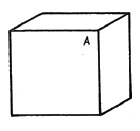 In four-dimensional space, we have the tessaract. A tessaract is bounded by eight cubes. The projection of a tessaract [in three-dimensional space] therefore consists of eight interlocking cubes. We have seen how the [corresponding eight] cubes can be intertwined in three-dimensional space. Today I will show you a [different] way of projecting the tessaract. You can imagine that the cube, when held up to the light, throws a shadow on the blackboard. We can mark this shadow figure with chalk (Figure 43). You see that a hexagon is obtained. Now imagine this cube transparent, and you will observe that in the hexagonal figure the three front sides of the cube and the three rear sides of the cube fall into the same plane. 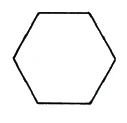 In order to get a projection that we can apply to the tessaract, I would ask you to imagine that the cube is standing in front of you in such a way that the front point A covers the rear point C. If you imagine the third dimension, all this would give you a hexagonal shadow again. I will draw the figure for you (Figure 44). 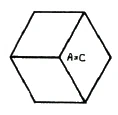 If you imagine the cube like this, you would see the three front surfaces here; the other surfaces would be behind them. The surfaces of the cube appear foreshortened and the angles are no longer right angles. This is how you see the cube depicted so that the surfaces form a regular hexagon. Thus, we have obtained a representation of a three-dimensional cube in two-dimensional space. Since the edges are shortened and the angles are changed by the projection, we must therefore imagine the [projection of the] six boundary squares of the cube as shifted squares, as rhombi. The same story that I did with a three-dimensional cube that I projected into the plane, we want to do this procedure with a four-dimensional spatial object, which we therefore have to place in three-dimensional space. We must therefore bring the structure composed of eight cubes, the tessaract, into the third dimension [by parallel projection]. With the cube, we obtained three visible and three invisible edges, all of which enter into the space and in reality do not lie within the [projection] surface. Now imagine a cube shifted in such a way that it becomes a rhombicuboctahedron.” Take eight of these figures, and you have the possibility of combining the eight [boundary] cubes of the tessaract in such a way that, when pushed together, they form the eight (doubly covered) rhombicuboctahedra of this spatial figure (Figure 45). 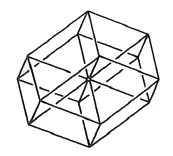 Now you have one more axis here [than in the three-dimensional cube]. Accordingly, a four-dimensional spatial structure naturally has four axes. So if we push it together, four axes still remain. There are eight [pushed together] cubes in this projection, which are represented as rhombicuboctahedra. The rhombicuboctahedron is a [symmetrical] image or silhouette of the tessaract in three-dimensional space. We arrived at this relationship by means of an analogy, but it is completely correct: just as we obtained a projection of the cube onto a plane, it is also possible to represent the tessaract in three-dimensional space by means of a projection. It behaves in the same way as the silhouette of the cube in relation to the cube itself. I think that is quite easy to understand. Now I would like to tie in with the greatest image that has ever been given for this, namely Plato and Schopenhauer and the parable of the cave. Plato says: Imagine people sitting in a cave, and they are all tied up so that they cannot turn their heads and can only look at the opposite wall. Behind them are people carrying various objects past them. These people and these objects are three-dimensional. So all these [bound] people stare at the wall and see only what is cast as a shadow [of the objects] on the wall. So they would see everything in the room only as a shadow on the opposite wall as two-dimensional images. Plato says that this is how it is in the world in general. In truth, people are sitting in the cave. Now, people themselves and everything else are four-dimensional; but what people see of it are only images in three-dimensional space. This is how all the things we see present themselves. According to Plato, we are dependent on seeing not the real things, but the three-dimensional silhouettes. I only see my hand as a silhouette; in reality it is four-dimensional, and everything that people see of it is just as much an image of it as what I just showed you as an image of the Tessaract. Thus Plato was already trying to make clear that the objects we know are actually four-dimensional, and that we only see silhouettes of them in three-dimensional space. And that is not entirely arbitrary. I will give you the reasons for this in a moment. Of course, anyone can say from the outset that this is mere speculation. How can we even imagine that the things that appear on the wall have a reality? Imagine that you are sitting here in a row, and you are sitting very still. Now imagine that the things on the wall suddenly start to move. You will not be able to tell yourself that the images on the wall can move without going out of the second dimension. If something moves there, it indicates that something must have happened outside the wall, on the real object, for it to move at all. That's what you tell yourself. If you imagine that the objects in three-dimensional space can pass each other, this would not be possible with their two-dimensional silhouettes, if you think of them as substantial, that is, impenetrable. If those images, conceived substantially, wanted to move past each other, they would have to go out of the second dimension. As long as everything on the wall is at rest, I have no reason to conclude that something is happening outside the wall, outside the space of the two-dimensional silhouettes. But the moment history begins to move, I must investigate the source of the motion. And you realize that the change can only come from motion outside the wall, only from motion within a third dimension. The change has thus told us that there is a third dimension in addition to the second. What is a mere image also has a certain reality, possesses very definite properties, but differs essentially from the real object. You will not be able to deny that the mirror image is also a mere image. You see yourself in the mirror, and you are also there. If there is not a third [that is, an active being] there, then you could not actually know what you are. But the mirror image makes the same movements that the original makes; the image is dependent on the real object, the being; it itself has no ability [to move]. Thus, a distinction can be made between image and being in that only a being can bring about movement and change out of itself. I realize from the shadows on the wall that they cannot move themselves, so they cannot be beings. I have to go out of them if I want to get to the beings. Now apply this to the world in general. The world is three-dimensional. Take this three-dimensional world for itself, as it is; grasp it completely in your thoughts [for yourself], and you will find that it remains rigid. It remains three-dimensional even if you suddenly think the world frozen at a certain point in time. But there is no one and the same world in two points in time. The world is completely different at successive points in time. Imagine that these points in time cease to exist, so that what is there remains. Without time, no change would occur in the world. The world would remain three-dimensional even if it underwent no change at all. The pictures on the wall also remain two-dimensional. But change suggests a third dimension. The fact that the world is constantly changing, and that it remains three-dimensional even without change, suggests that we have to look for the change in a fourth dimension. We have to look for the reason, the cause of the change, the activity outside the third dimension, and with that you have initially uncovered the fourth of the dimensions. But with that you also have the justification for Plato's image. So we understand the whole three-dimensional world as the shadow projection of a four-dimensional world. The only question is how we have to take this fourth dimension [in reality]. You see, we have the one idea to make it clear to ourselves, of course, that it is impossible for the fourth dimension to fall [directly] into the third. That is not possible. The fourth dimension cannot fall into the third. I would like to show you now how one can, so to speak, get an idea of how to go beyond the third dimension. Imagine we have a circle – I have already tried to evoke a similar idea recently – if you imagine this circle getting bigger and bigger, then a piece of this circle becomes flatter and flatter, and because the diameter of the circle becomes very large at the end, the circle finally turns into a straight line. The line has one dimension, but the circle has two dimensions. How do you get a second dimension from a single dimension? By curving a straight line, you get a circle again. If you now imagine the surface of the circle curving into space, you first get a shell, and if you continue to do this, you get a sphere. Thus a line acquires a second dimension by curvature and a surface acquires a third dimension by curvature. If you could now curve a cube, it would have to be curved into the fourth dimension, and you would have the [spherical] tessaract. You can understand the sphere as a curved two-dimensional spatial structure. The sphere that occurs in nature is the cell, the smallest living thing. The cell is limited spherically. That is the difference between the living and the lifeless. The mineral always occurs as a crystal bounded by flat surfaces; life is bounded by spherical surfaces, built up of cells. That means that just as a crystal is built from spheres that have been straightened out, that is, from planes, so life is built from cells, that is, from spheres that have been bent together. The difference between the living and the dead lies in the way they are defined. The octahedron is defined by eight triangles. If we imagine the eight sides as spheres, we would get an eight-limbed living thing. If you curve the three-dimensional structure, the cube, again, you get a four-dimensional structure, the spherical tessaract. But if you curve the whole space, you get something that relates to three-dimensional space in the same way that a sphere relates to a plane. Just as the cube, as a three-dimensional structure, is bounded by planes, so every crystal is bounded by planes. The essence of a crystal is the assembly of [flat] boundary planes. The essence of the living is the assembly of curved surfaces, of cells. The assembly of something even higher would be a structure whose individual boundaries would be four-dimensional. A three-dimensional structure is bounded by two-dimensional structures. A four-dimensional being, that is, a living being, is bounded by three-dimensional beings, by spheres and cells. A five-dimensional being is itself bounded by four-dimensional beings, by spherical tessaracts. From this you can see that we have to ascend from three-dimensional to four-dimensional, and then to five-dimensional beings. We only have to ask ourselves: What must occur in a being that is four-dimensional?* A change must occur within the third dimension. In other words: If you hang pictures on the wall here, they are two-dimensional and generally remain static. But if you have pictures in which the second dimension moves and changes, then you must conclude that the cause of this movement can only lie outside the surface of the wall, that the third dimension of space thus indicates the change. If you find changes within the third spatial dimension itself, then you must conclude that a fourth dimension is involved, and this brings us to the beings that undergo a change within their three spatial dimensions. It is not true that we have fully recognized a plant if we have only recognized it in its three dimensions. A plant is constantly changing, and this change is an essential, a higher characteristic of it. The cube remains; it only changes its shape when you smash it. A plant changes its shape itself, that is, there is something that is the cause of this change and that lies outside the third dimension and is an expression of the fourth dimension. What is that? You see, if you have this cube and draw it, you would labor in vain if you wanted to draw it differently at different moments; it will always remain the same. If you draw the plant and compare the picture with your model after three weeks, it will have changed. So this analogy is completely accurate. Everything that lives points to something higher, where it has its true essence, and the expression of this higher is time. Time is the symptomatic expression, the appearance of liveliness [understood as the fourth dimension] in the three dimensions of physical space. In other words, all beings for whom time has an inner meaning are images of four-dimensional beings. This cube is still the same after three or six years. The lily bud changes. Because for it, time has a real meaning. Therefore, what we see in the lily is only the three-dimensional image of the four-dimensional lily being. So time is an image, a projection of the fourth dimension, the organic liveliness, into the three spatial dimensions of the physical world. To understand how a following dimension relates to the preceding one, please imagine the following: a cube has three dimensions; when you visualize the third, you have to remember that it is perpendicular to the second, and the second is perpendicular to the first. The three dimensions are characterized by the fact that they are perpendicular to one another. But we can also imagine how the third dimension arises from the following [fourth dimension]. Imagine that you would change the cube by coloring the boundary surfaces and then changing these colors [in a certain way, as in Hinton's example]. Such a change can indeed be made, and it corresponds exactly to the change that a three-dimensional being undergoes when it passes into the fourth dimension, when it develops through time. If you cut a four-dimensional being at any point, you take away the fourth dimension, you destroy it. If you do that to a plant, you do exactly the same thing as if you were to make a cast of the plant, a plaster cast. You have captured that by destroying the fourth dimension, time. Then you get a three-dimensional object. If for any three-dimensional being the fourth dimension, time, has an essential significance, then it is a living being. Now we enter the fifth dimension. You can say to yourself that you must again have a boundary that is perpendicular to the fourth dimension. We have seen that the fourth dimension is related to the third dimension in a similar way to the third dimension being related to the second. It is not immediately possible to visualize the fifth dimension in this way. But you can again create a rough idea by using an analogy. How does a dimension come into being in the first place? If you simply draw a line, you will never create another dimension by simply pushing the line in one direction. Only by imagining that you have two opposing directions of force, which then accumulate at a point, only by expressing the accumulation, do you have a new dimension. We must therefore be able to grasp the new dimension as a new line of accumulation [of two currents of force], and imagine the one dimension coming from the right one time and from the left the next, as positive and negative. So I understand a dimension [as a polar [stream of forces] within itself], so that it has a positive and a negative dimension [component], and the neutralization [of these polar force components] is the new dimension. From there, we want to create an idea of the fifth dimension. We will have to imagine that the fourth dimension, which we have found expressed as time, behaves in a positive and negative way. Now take two beings for whom time has a meaning, and imagine two such beings colliding with each other. Then something must appear as a result, similar to what we have previously called an accumulation of [opposing] forces; and what arises as a result when two four-dimensional beings come into relation with each other is their fifth dimension. This fifth dimension arises as a result, as a consequence of an exchange [a neutralization of polar force effects], in that two living beings, through their mutual interaction, produce something that they do not have outside [in the three ordinary spatial dimensions together], nor do they have in [the fourth dimension,] time, but have completely outside these [previously discussed dimensions or] boundaries. This is what we call compassion [or feeling], by which one being knows another, thus the realization of the [spiritual and mental] inner being of another being. A being could never know anything about another being outside of time [and space] if you did not add a higher, fifth dimension, [i.e. enter the world of] sensation. Of course, here the sensation is only to be understood as a projection, as an expression [of the fifth dimension] in the physical world. Developing the sixth dimension in the same way would be too difficult, so I will only indicate it. [If we tried to progress in this way, something could be developed as an expression of the sixth dimension that,] when placed in the three-dimensional physical world, is self-conscious. Man, as a three-dimensional being, is one who shares his imagery with other three-dimensional beings. The plant, in addition, has the fourth dimension. For this reason, you will never find the ultimate essence of the plant within the three dimensions of space, but you would have to ascend from the plant to a fourth spatial dimension [to the astral sphere]. But if you wanted to grasp a being that has feeling, you would have to ascend to the fifth dimension [to the lower Devachan, to the Rupa sphere]; and if you wanted to grasp a being that has self-awareness, a human being, you would have to ascend to the sixth dimension [to the upper Devachan, to the Arupa sphere]. Thus, the human being as he stands before us in the present is indeed a six-dimensional being. That which is called feeling or compassion, or self-awareness, is a projection of the fifth or sixth dimension into ordinary three-dimensional space. Man extends into these spiritual spheres, albeit unconsciously for the most part; only there can he actually be experienced in the sense indicated last. This six-dimensional being can only come to an idea of even the higher worlds if it tries to get rid of the actual characteristics of the lower dimensions. I can only hint at the reason why man considers the world to be only three-dimensional, namely because he is conditioned in his perception to see only a reflection of something higher in the world. When you look in a mirror, you also see only a reflection of yourself. Thus, the three dimensions of our physical space are indeed reflections, material copies of three higher, causally creative dimensions. Our material world therefore has its polar [spiritual] counter-image in the group of the three next higher dimensions, that is, in those of the fourth, fifth and sixth dimensions. And in a similar sense, the spiritual worlds that lie beyond this group of dimensions, which can only be sensed, are also polar to those of the fourth to sixth dimensions. If you have water and you let the water freeze, the same substance is present in both cases; but in form they differ quite substantially. You can imagine a similar process for the three higher dimensions of man. If you think of man as a purely spiritual being, then you have to think of him as having only the three higher dimensions – self-awareness, feeling and time – and these three dimensions are reflected in the physical world in its three ordinary dimensions. The yogi [secret student], if he wants to advance to a knowledge of the higher worlds, must gradually replace the mirror images with reality. For example, when he looks at a plant, he must get used to gradually substituting the higher dimensions for the lower ones. If he looks at a plant and is able to abstract from one spatial dimension in the case of a plant, to abstract from one spatial dimension and instead to imagine a corresponding one of the higher dimensions, in this case time, then he actually gets an idea of what a two-dimensional, moving being is. To make this being more than just an image, to make it correspond to reality, the yogi must do the following. If he disregards the third dimension and adds the fourth, he would only get something imaginary. However, the following mental image can help: when we make a cinematographic representation of a living being, we remove the third dimension from the original three-dimensional processes, but add the [dimension of] time through the sequence of images. If we then add sensation to this [moving] perception, we perform a procedure similar to what I described earlier as the bending of a three-dimensional structure into the fourth dimension. Through this process you then get a four-dimensional entity, but now one that has two of our spatial dimensions, but also two higher ones, namely time and sensation. Such beings do indeed exist, and these beings - and this brings me to a real conclusion to the whole consideration - I would like to tell you about. Imagine two spatial dimensions, that is, a surface, and this surface endowed with motion. Now imagine a bent as a sensation, a sentient being that then pushes a two-dimensional surface in front of it. Such a being must act differently and be very different from a three-dimensional being in our space. This flat creature that we have constructed in this way is incomplete in one direction, completely open, and offers you a two-dimensional view; you cannot go around it, it comes towards you. This is a luminous creature, and the luminous creature is nothing other than the incompleteness in one direction. Through such a being, the initiates then get to know other beings, which they describe as divine messengers approaching them in flames of fire. The description of Mount Sinai, where Moses received the Ten Commandments,® means nothing other than that a being could indeed approach him that, to his perception, had these dimensions. It appeared to him like a human being from whom the third spatial dimension had been removed; it appeared in sensation and in time. These abstract images in the religious documents are not just external symbols, but powerful realities that man can get to know if he is able to appropriate what we have tried to make clear through analogies. The more you devote yourself diligently and energetically to such considerations of analogies, the more you really work on your mind, and the more these [considerations] work in us and trigger higher abilities. [This is roughly the case when dealing with] the analogy of the relationship of the cube to the hexagon and the tessaract to the rhombic dodecahedron. The latter represents a projection of the tessaract into the three-dimensional physical world. If you visualize these figures as living entities, if you allow the cube to grow out of the projection of the die – the hexagon – and likewise allow the tessaract itself to arise from the projection of the tessaract [the rhombic dodecahedron], then you create the possibility and the ability in your lower mental body to grasp what I have just described to you as a structure. And if, in other words, you have not only followed me but have gone through this procedure vividly, as the yogi does in an awakened state of consciousness, then you will notice that something will occur to you in your dreams that in reality is a four-dimensional entity, and then it is not much further to bring it over into the waking consciousness, and you can then see the fourth dimension in every four-dimensional being. The astral sphere is the fourth dimension. Devachan to rupa is the fifth dimension. Devachan to arupa is the sixth dimension. These three worlds, the physical, astral and celestial [devachan], comprise six dimensions. The even higher worlds are completely polar to these. Mineral Plant Animal Human Arupa Self-consciousness Rupa Sensation Self-consciousness Astral plane Life Sensation Self-consciousness Physical form Life Sensation Self-plan consciousness Form Life Sensation Form Life Form |
| 324a. The Fourth Dimension (2024): Four-Dimensional Space
07 Nov 1905, Berlin Rudolf Steiner |
|---|
| 324a. The Fourth Dimension (2024): Four-Dimensional Space
07 Nov 1905, Berlin Rudolf Steiner |
|---|
Our ordinary space has three dimensions: length, width and height. A line extends in one dimension, it has only length. A table is a surface, so it has two dimensions: length and width. A body extends in three dimensions. How does a body of three dimensions come about? Imagine a shape that has no dimensionality at all: that is the point. It has zero dimensions. When a point moves in one direction, a straight line is created, a one-dimensional shape. If you imagine the line continuing, a surface with length and width is created. Finally, if you imagine the surface moving, it describes a three-dimensional shape. But we cannot use the same method to create a fourth dimension from a three-dimensional object [through movement]. We must try to visualize how we can arrive at the concept of a fourth dimension. [Certain] mathematicians [and natural scientists] have felt compelled to harmonize the spiritual world with our sensual world [by placing the spiritual world in a four-dimensional space], for example, Zöllner. 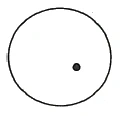 Imagine a circle. It is closed on all sides in the plane. If someone demands that a coin should come into the circle from outside, we have to cross the circle line (Figure 46). But if you do not want to touch the circle line, you have to lift the coin [into the space] and then put it in. You must necessarily go from the second to the third dimension. If we wanted to conjure a coin into a cube [or into a sphere], we would have to go [out of the third dimension and] through the fourth dimension.' In this life, the first time I began to grasp what space actually is was when I started to study recent [synthetic projective] geometry. Then I realized what it means to go from a circle to a line (Figure 47). In the most intimate thinking of the soul, the world opens up. 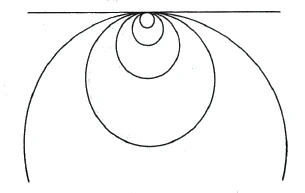 Now let us imagine a circle. If we follow the circle line, we can walk around it and return to the original point. Now let us imagine the circle getting bigger and bigger [holding a tangent line]. In the end, it must merge into a straight line because it flattens out more and more. [When I go through the enlarging circles, I always go down on one side and then come up on the other side and back to the starting point. If I finally move on the straight line, for example to the right into infinity, I have to return from the other side of infinity, since the straight line behaves like a circle in terms of the arrangement of its points. From this we see that space has no end [in the same sense that the straight line has no end, that is, the arrangement of its points is the same as in a closed circle. Accordingly, we must think of infinitely extended space as closed in itself, just as the surface of a sphere is closed in itself]. Thus you have represented infinite space [in the sense of] a circle [or] a sphere. This concept leads us to imagine space in its reality. If I now imagine that I do not simply disappear [into infinity] and then return [unchanged from the other side], but think to myself that I have a radiating light, this will become weaker and weaker as I move away (seen from a stationary point on the line) and stronger and stronger when I return (with the light from infinity). And if we consider that this light not only has a positive effect, but, as it approaches from the other side here, shines all the more strongly, then you have [here the qualities] positive and negative. In all natural effects, you will find these two poles, which represent nothing other than the opposite effects of space. From this you get the idea that space is something powerful, and that the forces that work in it are nothing other than the outflow of the power itself. Then we will have no doubt that within our three-dimensional space there could be a force that works from within. You will realize that everything that occurs in space is based on real relationships in space. If we were to intertwine two dimensions, we would have brought these two into relation. If you want to entwine two [closed] rings, you have to unravel one of them to get the other inside. But now I will demonstrate the inner diversity of space by entwining this structure [a rectangular paper band] twice around itself [that is, holding one end and twisting the other end 360° and then holding the two ends together]. I pin the paper tape together tightly with pins and cut it in half. Now one tape is firmly stuck inside the other. Before that, it was just one tape. So here, by merely intertwining the tapes within the three dimensions, I have created the same thing that I would otherwise have to reach out into the [fourth] dimension to achieve." This is not a gimmick, but reality. If we have the sun here, and the earth's orbit around the sun here, and the moon's orbit around the earth here (Figure 48), we have to imagine that the earth moves around the sun and therefore the moon's orbit and the earth's orbit are intertwined exactly [like our two paper ribbons]. Now the moon has branched off from the earth [in the course of the earth's development]. This is an internal bifurcation that has occurred in the same way [as the intertwining of our two paper ribbons]. [Through such a way of looking at it] space comes alive in itself. 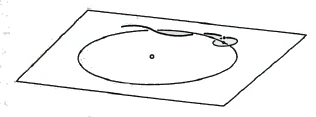 Now consider a square. Imagine it moving through space in such a way that it forms a cube. Then it must progress within itself. A cube is composed of six squares, which together form the surface of the cube. To put the cube together [in a clear way], I first place the six squares next to each other [in a plane] (Figure 49). I get the cube again when I put these squares on top of each other. I then have to place the sixth on top by going through the third dimension. Thus I have now laid the cube out in two dimensions. I have transformed a three-dimensional structure by laying it out in two dimensions. 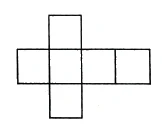 Now imagine that the boundaries of a cube are squares. If I have a three-dimensional cube here, it is bounded by two-dimensional squares. Let's just take a single square. It is two-dimensional and is bounded by four one-dimensional lines. I can expand the four lines into a single dimension (Figure 50). What appears in the one dimension, I will now paint in red [solid line] and the other dimension in blue [dotted line]. Now, instead of saying length and width, I can speak of the red and blue dimensions.  I can reassemble the cube from six squares. So now I go from the number four [the number of side lines of the square] to the number six [the number of the side surfaces of the cube]. If I go one step further, I get from the number six [the number of the side surfaces of the cube] to the number eight [the number of “side cubes” of a four-dimensional structure]. I now arrange the eight cubes in such a way that the corresponding structure is created in three-dimensional space to that which was previously constructed in two-dimensional space (Figure 51) from six squares. 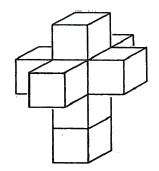 Imagine that I could turn this structure inside out so that I could turn it right way up and put it together in such a way that I could cover the whole structure with the eighth cube. Then I would get a four-dimensional structure in a four-dimensional space from the eight cubes. This figure is called [by Hinton] the tessaract. Its limiting figure is eight cubes, just as the ordinary cube has six squares as its limiting figure. The [four-dimensional] tessaract is therefore bounded by [eight] three-dimensional cubes. Imagine a creature that can only see in two dimensions, and this creature would now look at the squares laid out separately, it would only see the squares 1, 2, 3, 4 and 6, but never the hatched square 5 in the middle (Figure 52). It is quite the same for you with the four-dimensional structure. [Since you can only see three-dimensional objects, you] cannot see the hidden cube in the middle. 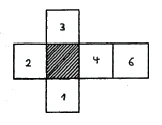 Now imagine the cube drawn on the board like this [so that the outline forms a regular hexagon]. The other side is hidden behind it. This is a kind of silhouette, a projection of the cube into two-dimensional space (Figure 53). This two-dimensional silhouette of a three-dimensional cube consists of rhombi, oblique rectangles [parallelograms]. If you imagine the cube made of wire, you would also be able to see the rhomboid squares at the back. So here you have six interlocking rhomboid squares in the projection. In this way you can project the whole cube into two-dimensional space.  Now imagine our tetrahedron formed in four-dimensional space. If you project this figure into three-dimensional space, you should get four non-intersecting rhombic parallelpipeds. One of these rhombic parallelpipeds should be drawn as follows (Figure 54). 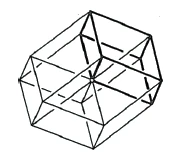 Eight such shifted rhombic cubes would have to be inserted into each other in order to obtain a three-dimensional image of the four-dimensional tessaract in three-dimensional space. Thus, we can represent the three-dimensional shadow image of such a tessaract with the help of eight rhombic cubes that are suitably inserted into each other. The spatial structure that results is a rhombic dodecahedron with four spatial diagonals (Figure 55). Just as in the rhombus representation of the cube, three directly neighboring rhombuses are shifted into each other, so that only three of the six cube surfaces are seen in the projection, only four non-intersecting rhombic cubes appear in the rhombic dodecahedron only four non-intersecting rhombic cubes appear as projections of the eight boundary cubes, since four of the directly neighboring rhombic cubes completely cover the remaining four.'> 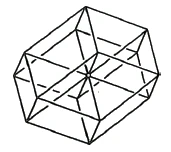 We can construct the three-dimensional shadow of a four-dimensional body, but not the tessaract itself. In the same sense, we are the shadows of four-dimensional beings. Thus, as man rises from the physical to the astral, he must develop his powers of visualization. Let us imagine a two-dimensional being who makes an [intense and repeated] effort to vividly imagine such a [three-dimensional] shadow image. When it then surrenders to the dream, then (...). When you mentally build up the relationship between the third and fourth dimensions, the forces at work within you allow you to see into [real, not mathematical] four-dimensional space. We will always be powerless in the higher world if we do not acquire the abilities [to see in the higher world] here [in the world of ordinary consciousness]. Just as a person in the womb develops eyes to see in the physical-sensual world, so must a person in the womb of the earth develop [supernatural] organs, then he will be born in the higher world [as a seer]. The development of the eyes in the womb is an [illuminating] example [of this process]. The cube would have to be constructed from the dimensions of length, width and height. The tessaract would have to be constructed from the dimensions of length, width, height and a fourth dimension. As the plant grows, it breaks through three-dimensional space. Every being that lives in time breaks through the three [ordinary] dimensions. Time is the fourth dimension. It is invisibly contained in the three dimensions of ordinary space. However, you can only perceive it through clairvoyant power. A moving point creates a line; when a line moves, a surface is created; and when a surface moves, a three-dimensional body is created. If we now let the three-dimensional space move, we have growth [and development]. This gives you four-dimensional space, time [projected into three-dimensional space as movement, growth, development]. [The geometric consideration of the structure of the three ordinary dimensions] can be found in real life. Time is perpendicular to the three dimensions, it is the fourth, and it grows. When you bring time to life within you, sensation arises. If you increase the time within you, move it within yourself, you have the sentient animal being, which in truth has five dimensions. The human being actually has six dimensions. We have four dimensions in the etheric realm [astral plane], five dimensions in the astral realm [lower devachan] and six dimensions in the [upper] devachan. Thus the [spiritual] manifoldness swells up to you. The devachan, as a shadow cast into the astral realm, gives us the astral body; the astral realm, as a shadow cast into the etheric realm, gives us the etheric body, and so on. Time flows in one direction, which is the withering away of nature, and in the other direction it is the revival. The two points where they merge are birth and death. The future is constantly coming towards us. If life only went in one direction, nothing new would ever come into being. Man also has genius – that is his future, his intuitions, which flow towards him. The processed past is [the stream coming from the other side; it determines] the essence [of how it has become so far]. |


